Organisation behaviour Assignment : CAPCO
VerifiedAdded on 2021/01/02
|20
|6451
|257
AI Summary
Contribute Materials
Your contribution can guide someone’s learning journey. Share your
documents today.
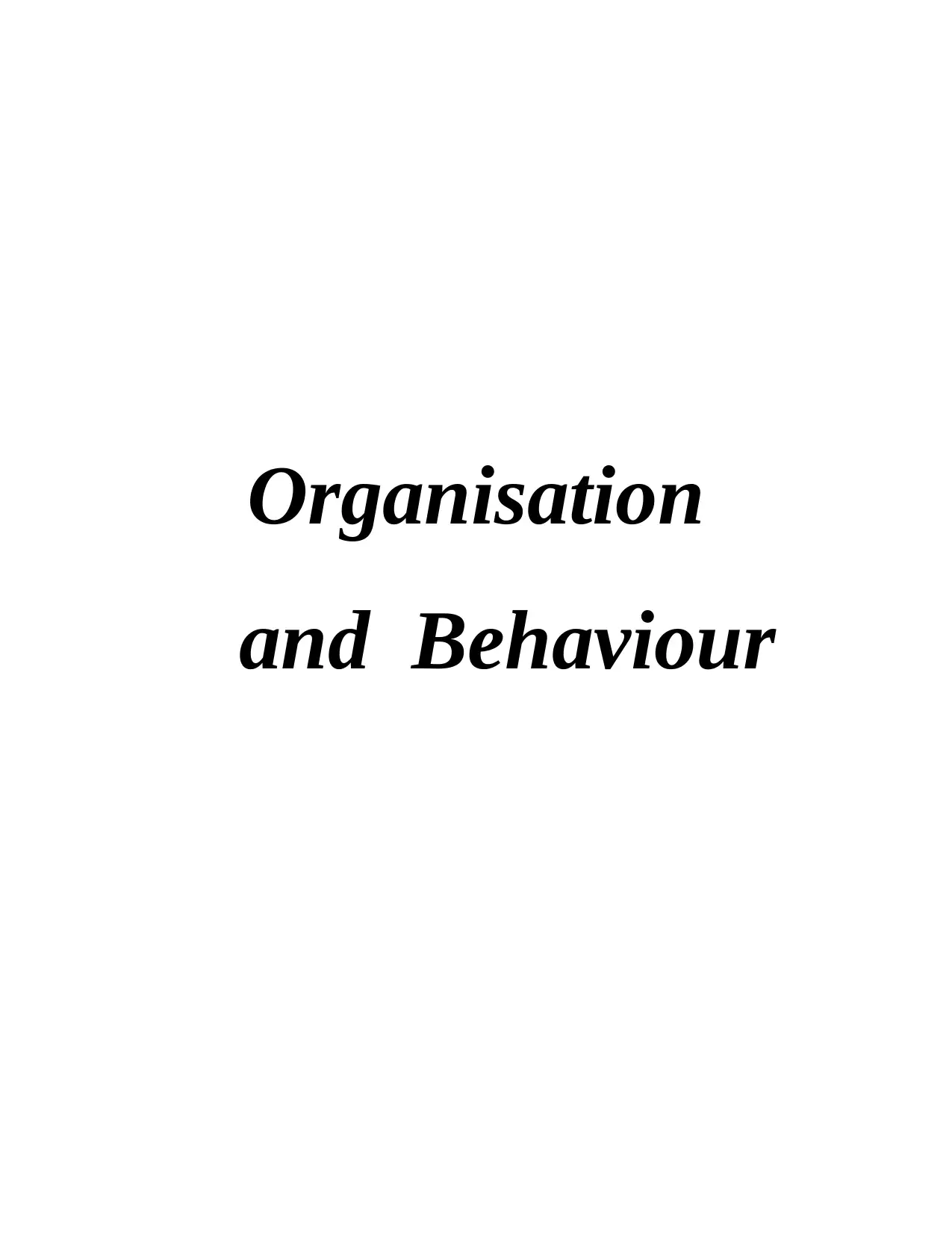
Organisation
and Behaviour
and Behaviour
Secure Best Marks with AI Grader
Need help grading? Try our AI Grader for instant feedback on your assignments.
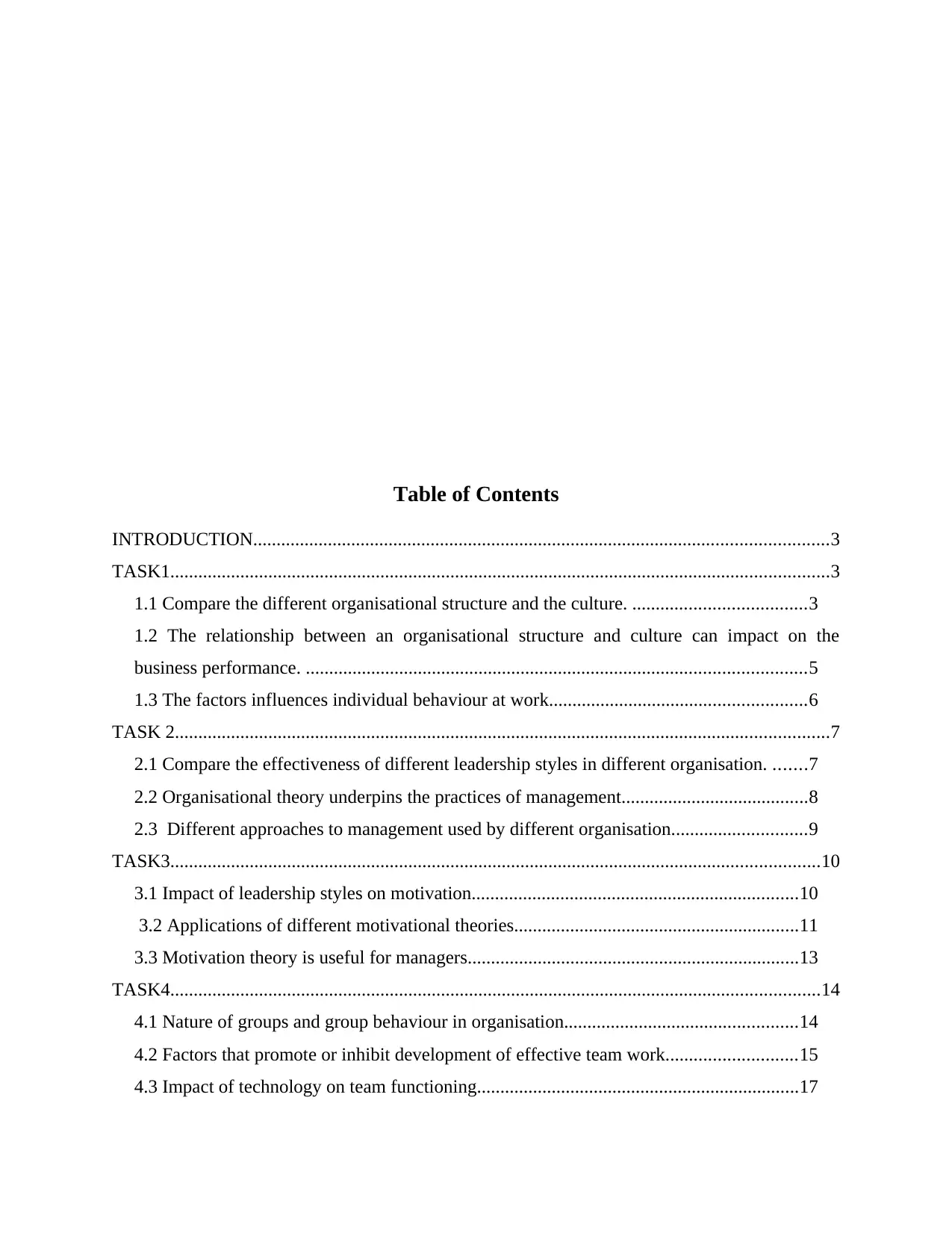
Table of Contents
INTRODUCTION...........................................................................................................................3
TASK1.............................................................................................................................................3
1.1 Compare the different organisational structure and the culture. .....................................3
1.2 The relationship between an organisational structure and culture can impact on the
business performance. ...........................................................................................................5
1.3 The factors influences individual behaviour at work.......................................................6
TASK 2............................................................................................................................................7
2.1 Compare the effectiveness of different leadership styles in different organisation. .......7
2.2 Organisational theory underpins the practices of management........................................8
2.3 Different approaches to management used by different organisation.............................9
TASK3...........................................................................................................................................10
3.1 Impact of leadership styles on motivation......................................................................10
3.2 Applications of different motivational theories.............................................................11
3.3 Motivation theory is useful for managers.......................................................................13
TASK4...........................................................................................................................................14
4.1 Nature of groups and group behaviour in organisation..................................................14
4.2 Factors that promote or inhibit development of effective team work............................15
4.3 Impact of technology on team functioning.....................................................................17
INTRODUCTION...........................................................................................................................3
TASK1.............................................................................................................................................3
1.1 Compare the different organisational structure and the culture. .....................................3
1.2 The relationship between an organisational structure and culture can impact on the
business performance. ...........................................................................................................5
1.3 The factors influences individual behaviour at work.......................................................6
TASK 2............................................................................................................................................7
2.1 Compare the effectiveness of different leadership styles in different organisation. .......7
2.2 Organisational theory underpins the practices of management........................................8
2.3 Different approaches to management used by different organisation.............................9
TASK3...........................................................................................................................................10
3.1 Impact of leadership styles on motivation......................................................................10
3.2 Applications of different motivational theories.............................................................11
3.3 Motivation theory is useful for managers.......................................................................13
TASK4...........................................................................................................................................14
4.1 Nature of groups and group behaviour in organisation..................................................14
4.2 Factors that promote or inhibit development of effective team work............................15
4.3 Impact of technology on team functioning.....................................................................17
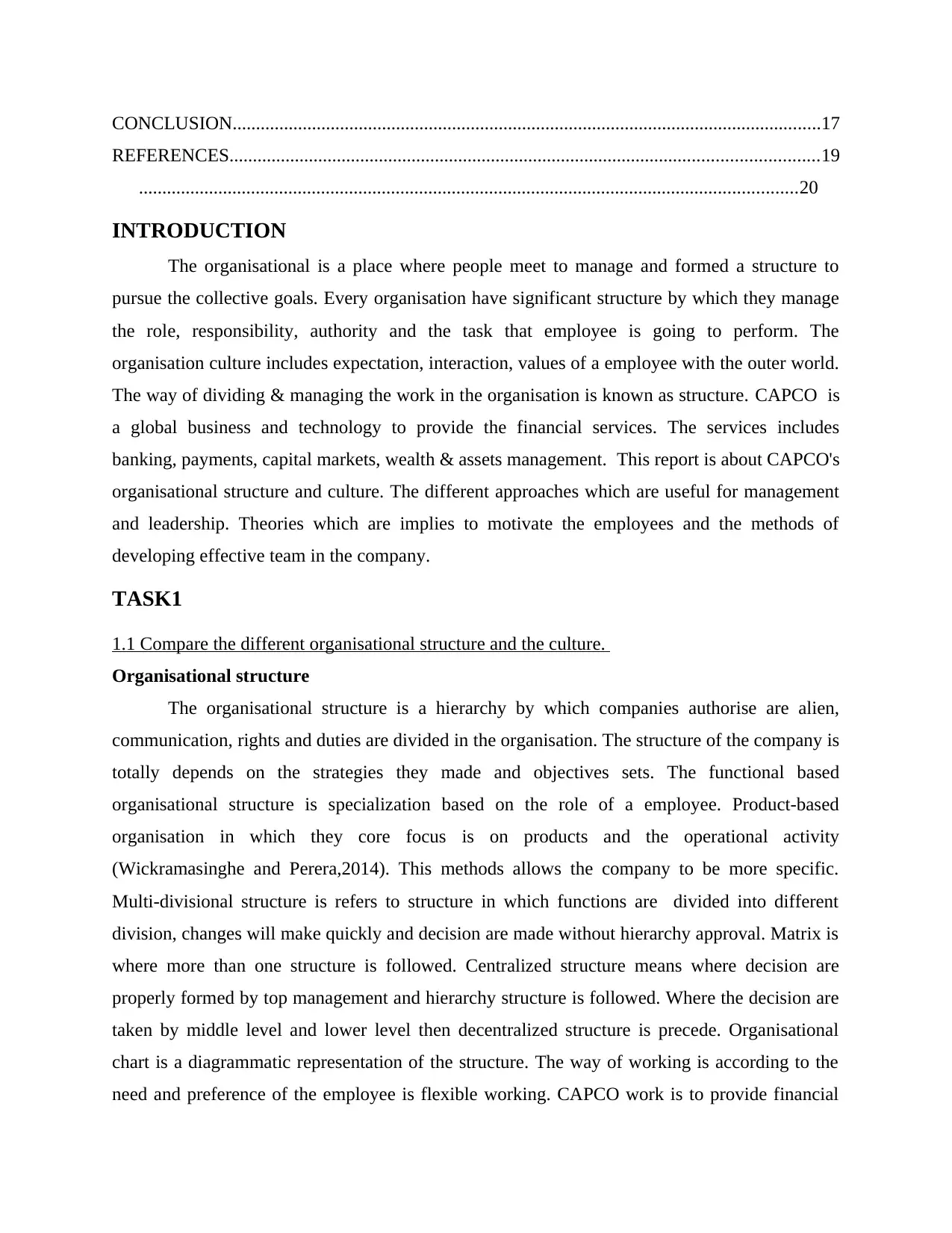
CONCLUSION..............................................................................................................................17
REFERENCES..............................................................................................................................19
.............................................................................................................................................20
INTRODUCTION
The organisational is a place where people meet to manage and formed a structure to
pursue the collective goals. Every organisation have significant structure by which they manage
the role, responsibility, authority and the task that employee is going to perform. The
organisation culture includes expectation, interaction, values of a employee with the outer world.
The way of dividing & managing the work in the organisation is known as structure. CAPCO is
a global business and technology to provide the financial services. The services includes
banking, payments, capital markets, wealth & assets management. This report is about CAPCO's
organisational structure and culture. The different approaches which are useful for management
and leadership. Theories which are implies to motivate the employees and the methods of
developing effective team in the company.
TASK1
1.1 Compare the different organisational structure and the culture.
Organisational structure
The organisational structure is a hierarchy by which companies authorise are alien,
communication, rights and duties are divided in the organisation. The structure of the company is
totally depends on the strategies they made and objectives sets. The functional based
organisational structure is specialization based on the role of a employee. Product-based
organisation in which they core focus is on products and the operational activity
(Wickramasinghe and Perera,2014). This methods allows the company to be more specific.
Multi-divisional structure is refers to structure in which functions are divided into different
division, changes will make quickly and decision are made without hierarchy approval. Matrix is
where more than one structure is followed. Centralized structure means where decision are
properly formed by top management and hierarchy structure is followed. Where the decision are
taken by middle level and lower level then decentralized structure is precede. Organisational
chart is a diagrammatic representation of the structure. The way of working is according to the
need and preference of the employee is flexible working. CAPCO work is to provide financial
REFERENCES..............................................................................................................................19
.............................................................................................................................................20
INTRODUCTION
The organisational is a place where people meet to manage and formed a structure to
pursue the collective goals. Every organisation have significant structure by which they manage
the role, responsibility, authority and the task that employee is going to perform. The
organisation culture includes expectation, interaction, values of a employee with the outer world.
The way of dividing & managing the work in the organisation is known as structure. CAPCO is
a global business and technology to provide the financial services. The services includes
banking, payments, capital markets, wealth & assets management. This report is about CAPCO's
organisational structure and culture. The different approaches which are useful for management
and leadership. Theories which are implies to motivate the employees and the methods of
developing effective team in the company.
TASK1
1.1 Compare the different organisational structure and the culture.
Organisational structure
The organisational structure is a hierarchy by which companies authorise are alien,
communication, rights and duties are divided in the organisation. The structure of the company is
totally depends on the strategies they made and objectives sets. The functional based
organisational structure is specialization based on the role of a employee. Product-based
organisation in which they core focus is on products and the operational activity
(Wickramasinghe and Perera,2014). This methods allows the company to be more specific.
Multi-divisional structure is refers to structure in which functions are divided into different
division, changes will make quickly and decision are made without hierarchy approval. Matrix is
where more than one structure is followed. Centralized structure means where decision are
properly formed by top management and hierarchy structure is followed. Where the decision are
taken by middle level and lower level then decentralized structure is precede. Organisational
chart is a diagrammatic representation of the structure. The way of working is according to the
need and preference of the employee is flexible working. CAPCO work is to provide financial
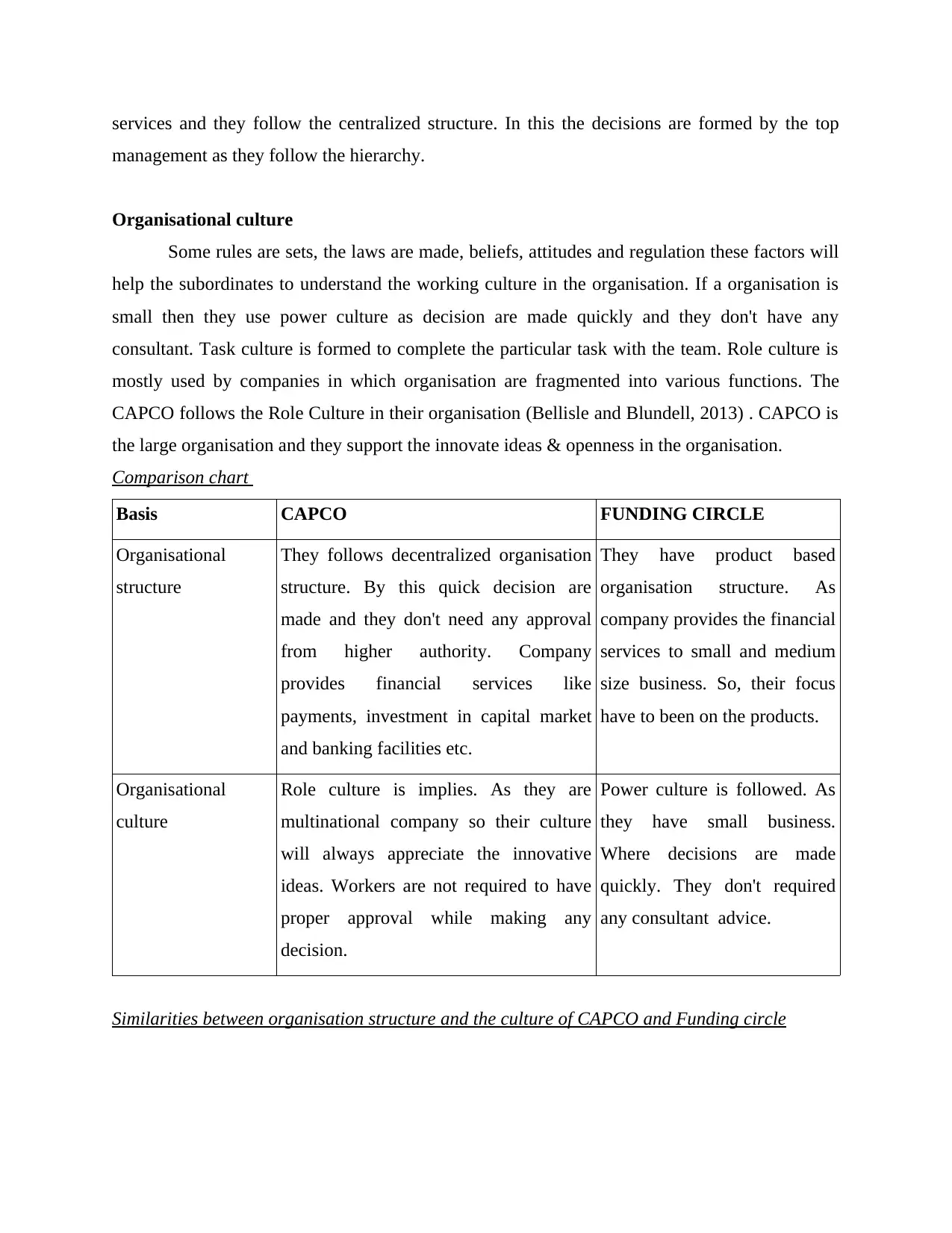
services and they follow the centralized structure. In this the decisions are formed by the top
management as they follow the hierarchy.
Organisational culture
Some rules are sets, the laws are made, beliefs, attitudes and regulation these factors will
help the subordinates to understand the working culture in the organisation. If a organisation is
small then they use power culture as decision are made quickly and they don't have any
consultant. Task culture is formed to complete the particular task with the team. Role culture is
mostly used by companies in which organisation are fragmented into various functions. The
CAPCO follows the Role Culture in their organisation (Bellisle and Blundell, 2013) . CAPCO is
the large organisation and they support the innovate ideas & openness in the organisation.
Comparison chart
Basis CAPCO FUNDING CIRCLE
Organisational
structure
They follows decentralized organisation
structure. By this quick decision are
made and they don't need any approval
from higher authority. Company
provides financial services like
payments, investment in capital market
and banking facilities etc.
They have product based
organisation structure. As
company provides the financial
services to small and medium
size business. So, their focus
have to been on the products.
Organisational
culture
Role culture is implies. As they are
multinational company so their culture
will always appreciate the innovative
ideas. Workers are not required to have
proper approval while making any
decision.
Power culture is followed. As
they have small business.
Where decisions are made
quickly. They don't required
any consultant advice.
Similarities between organisation structure and the culture of CAPCO and Funding circle
management as they follow the hierarchy.
Organisational culture
Some rules are sets, the laws are made, beliefs, attitudes and regulation these factors will
help the subordinates to understand the working culture in the organisation. If a organisation is
small then they use power culture as decision are made quickly and they don't have any
consultant. Task culture is formed to complete the particular task with the team. Role culture is
mostly used by companies in which organisation are fragmented into various functions. The
CAPCO follows the Role Culture in their organisation (Bellisle and Blundell, 2013) . CAPCO is
the large organisation and they support the innovate ideas & openness in the organisation.
Comparison chart
Basis CAPCO FUNDING CIRCLE
Organisational
structure
They follows decentralized organisation
structure. By this quick decision are
made and they don't need any approval
from higher authority. Company
provides financial services like
payments, investment in capital market
and banking facilities etc.
They have product based
organisation structure. As
company provides the financial
services to small and medium
size business. So, their focus
have to been on the products.
Organisational
culture
Role culture is implies. As they are
multinational company so their culture
will always appreciate the innovative
ideas. Workers are not required to have
proper approval while making any
decision.
Power culture is followed. As
they have small business.
Where decisions are made
quickly. They don't required
any consultant advice.
Similarities between organisation structure and the culture of CAPCO and Funding circle
Secure Best Marks with AI Grader
Need help grading? Try our AI Grader for instant feedback on your assignments.
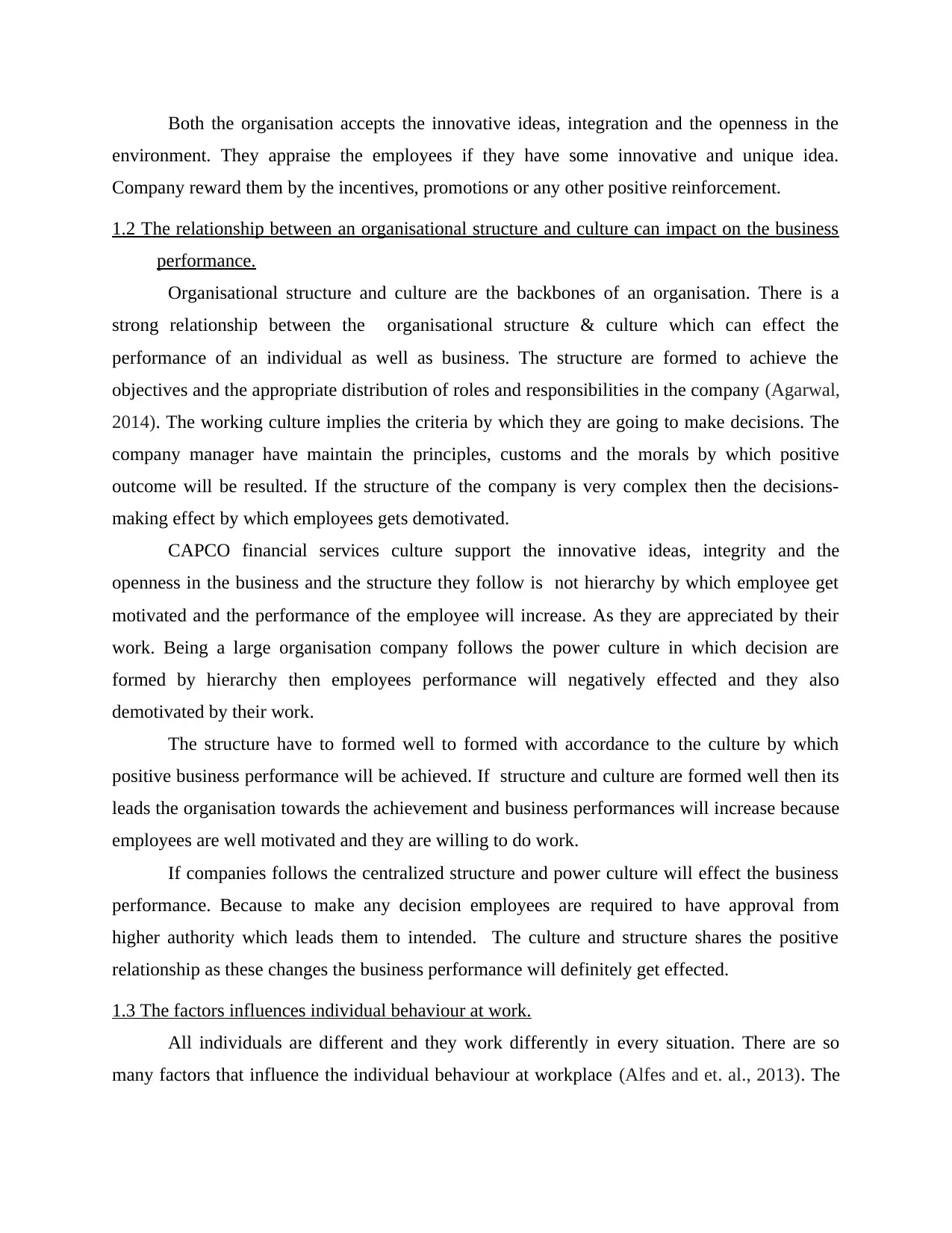
Both the organisation accepts the innovative ideas, integration and the openness in the
environment. They appraise the employees if they have some innovative and unique idea.
Company reward them by the incentives, promotions or any other positive reinforcement.
1.2 The relationship between an organisational structure and culture can impact on the business
performance.
Organisational structure and culture are the backbones of an organisation. There is a
strong relationship between the organisational structure & culture which can effect the
performance of an individual as well as business. The structure are formed to achieve the
objectives and the appropriate distribution of roles and responsibilities in the company (Agarwal,
2014). The working culture implies the criteria by which they are going to make decisions. The
company manager have maintain the principles, customs and the morals by which positive
outcome will be resulted. If the structure of the company is very complex then the decisions-
making effect by which employees gets demotivated.
CAPCO financial services culture support the innovative ideas, integrity and the
openness in the business and the structure they follow is not hierarchy by which employee get
motivated and the performance of the employee will increase. As they are appreciated by their
work. Being a large organisation company follows the power culture in which decision are
formed by hierarchy then employees performance will negatively effected and they also
demotivated by their work.
The structure have to formed well to formed with accordance to the culture by which
positive business performance will be achieved. If structure and culture are formed well then its
leads the organisation towards the achievement and business performances will increase because
employees are well motivated and they are willing to do work.
If companies follows the centralized structure and power culture will effect the business
performance. Because to make any decision employees are required to have approval from
higher authority which leads them to intended. The culture and structure shares the positive
relationship as these changes the business performance will definitely get effected.
1.3 The factors influences individual behaviour at work.
All individuals are different and they work differently in every situation. There are so
many factors that influence the individual behaviour at workplace (Alfes and et. al., 2013). The
environment. They appraise the employees if they have some innovative and unique idea.
Company reward them by the incentives, promotions or any other positive reinforcement.
1.2 The relationship between an organisational structure and culture can impact on the business
performance.
Organisational structure and culture are the backbones of an organisation. There is a
strong relationship between the organisational structure & culture which can effect the
performance of an individual as well as business. The structure are formed to achieve the
objectives and the appropriate distribution of roles and responsibilities in the company (Agarwal,
2014). The working culture implies the criteria by which they are going to make decisions. The
company manager have maintain the principles, customs and the morals by which positive
outcome will be resulted. If the structure of the company is very complex then the decisions-
making effect by which employees gets demotivated.
CAPCO financial services culture support the innovative ideas, integrity and the
openness in the business and the structure they follow is not hierarchy by which employee get
motivated and the performance of the employee will increase. As they are appreciated by their
work. Being a large organisation company follows the power culture in which decision are
formed by hierarchy then employees performance will negatively effected and they also
demotivated by their work.
The structure have to formed well to formed with accordance to the culture by which
positive business performance will be achieved. If structure and culture are formed well then its
leads the organisation towards the achievement and business performances will increase because
employees are well motivated and they are willing to do work.
If companies follows the centralized structure and power culture will effect the business
performance. Because to make any decision employees are required to have approval from
higher authority which leads them to intended. The culture and structure shares the positive
relationship as these changes the business performance will definitely get effected.
1.3 The factors influences individual behaviour at work.
All individuals are different and they work differently in every situation. There are so
many factors that influence the individual behaviour at workplace (Alfes and et. al., 2013). The
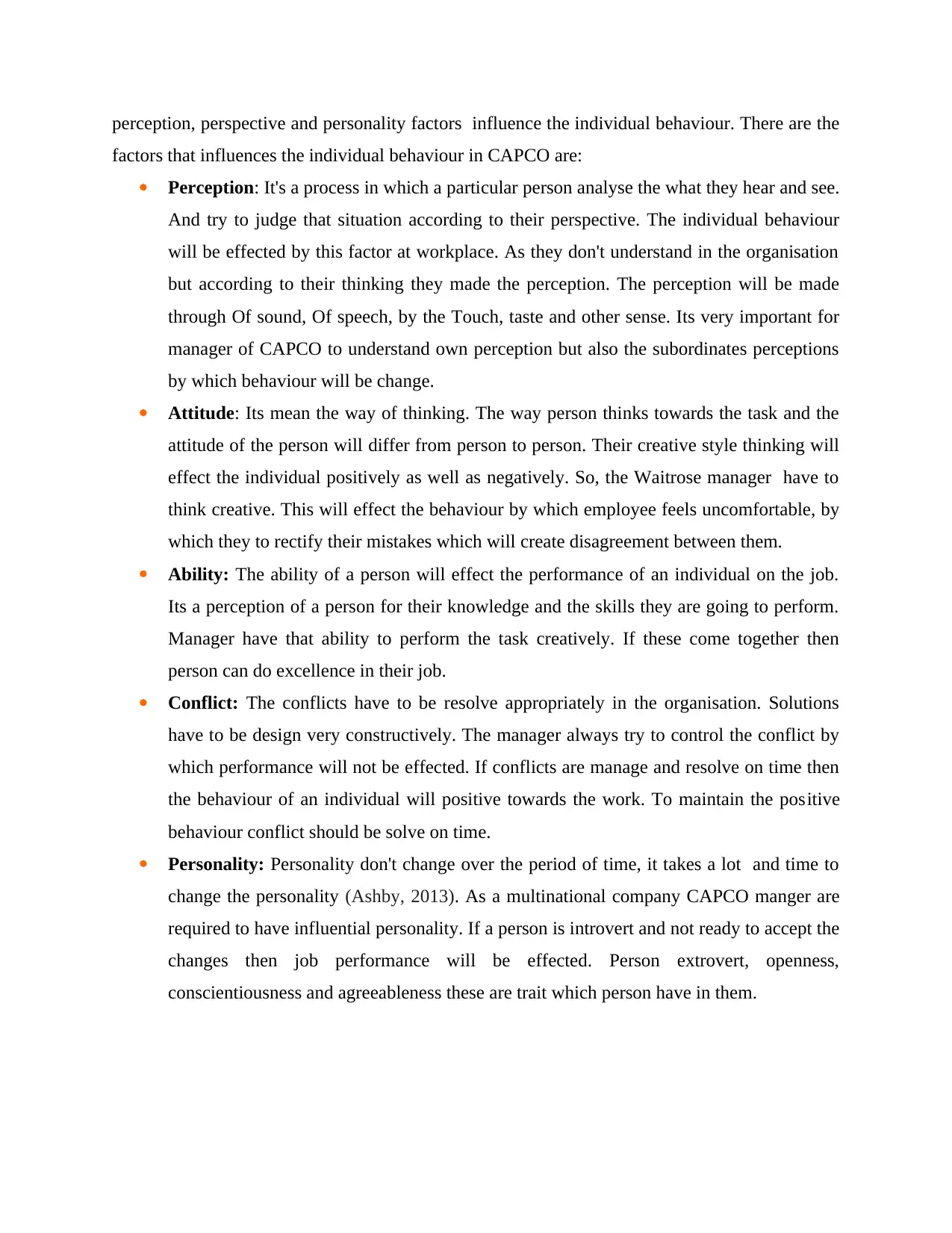
perception, perspective and personality factors influence the individual behaviour. There are the
factors that influences the individual behaviour in CAPCO are:
Perception: It's a process in which a particular person analyse the what they hear and see.
And try to judge that situation according to their perspective. The individual behaviour
will be effected by this factor at workplace. As they don't understand in the organisation
but according to their thinking they made the perception. The perception will be made
through Of sound, Of speech, by the Touch, taste and other sense. Its very important for
manager of CAPCO to understand own perception but also the subordinates perceptions
by which behaviour will be change.
Attitude: Its mean the way of thinking. The way person thinks towards the task and the
attitude of the person will differ from person to person. Their creative style thinking will
effect the individual positively as well as negatively. So, the Waitrose manager have to
think creative. This will effect the behaviour by which employee feels uncomfortable, by
which they to rectify their mistakes which will create disagreement between them.
Ability: The ability of a person will effect the performance of an individual on the job.
Its a perception of a person for their knowledge and the skills they are going to perform.
Manager have that ability to perform the task creatively. If these come together then
person can do excellence in their job.
Conflict: The conflicts have to be resolve appropriately in the organisation. Solutions
have to be design very constructively. The manager always try to control the conflict by
which performance will not be effected. If conflicts are manage and resolve on time then
the behaviour of an individual will positive towards the work. To maintain the positive
behaviour conflict should be solve on time.
Personality: Personality don't change over the period of time, it takes a lot and time to
change the personality (Ashby, 2013). As a multinational company CAPCO manger are
required to have influential personality. If a person is introvert and not ready to accept the
changes then job performance will be effected. Person extrovert, openness,
conscientiousness and agreeableness these are trait which person have in them.
factors that influences the individual behaviour in CAPCO are:
Perception: It's a process in which a particular person analyse the what they hear and see.
And try to judge that situation according to their perspective. The individual behaviour
will be effected by this factor at workplace. As they don't understand in the organisation
but according to their thinking they made the perception. The perception will be made
through Of sound, Of speech, by the Touch, taste and other sense. Its very important for
manager of CAPCO to understand own perception but also the subordinates perceptions
by which behaviour will be change.
Attitude: Its mean the way of thinking. The way person thinks towards the task and the
attitude of the person will differ from person to person. Their creative style thinking will
effect the individual positively as well as negatively. So, the Waitrose manager have to
think creative. This will effect the behaviour by which employee feels uncomfortable, by
which they to rectify their mistakes which will create disagreement between them.
Ability: The ability of a person will effect the performance of an individual on the job.
Its a perception of a person for their knowledge and the skills they are going to perform.
Manager have that ability to perform the task creatively. If these come together then
person can do excellence in their job.
Conflict: The conflicts have to be resolve appropriately in the organisation. Solutions
have to be design very constructively. The manager always try to control the conflict by
which performance will not be effected. If conflicts are manage and resolve on time then
the behaviour of an individual will positive towards the work. To maintain the positive
behaviour conflict should be solve on time.
Personality: Personality don't change over the period of time, it takes a lot and time to
change the personality (Ashby, 2013). As a multinational company CAPCO manger are
required to have influential personality. If a person is introvert and not ready to accept the
changes then job performance will be effected. Person extrovert, openness,
conscientiousness and agreeableness these are trait which person have in them.
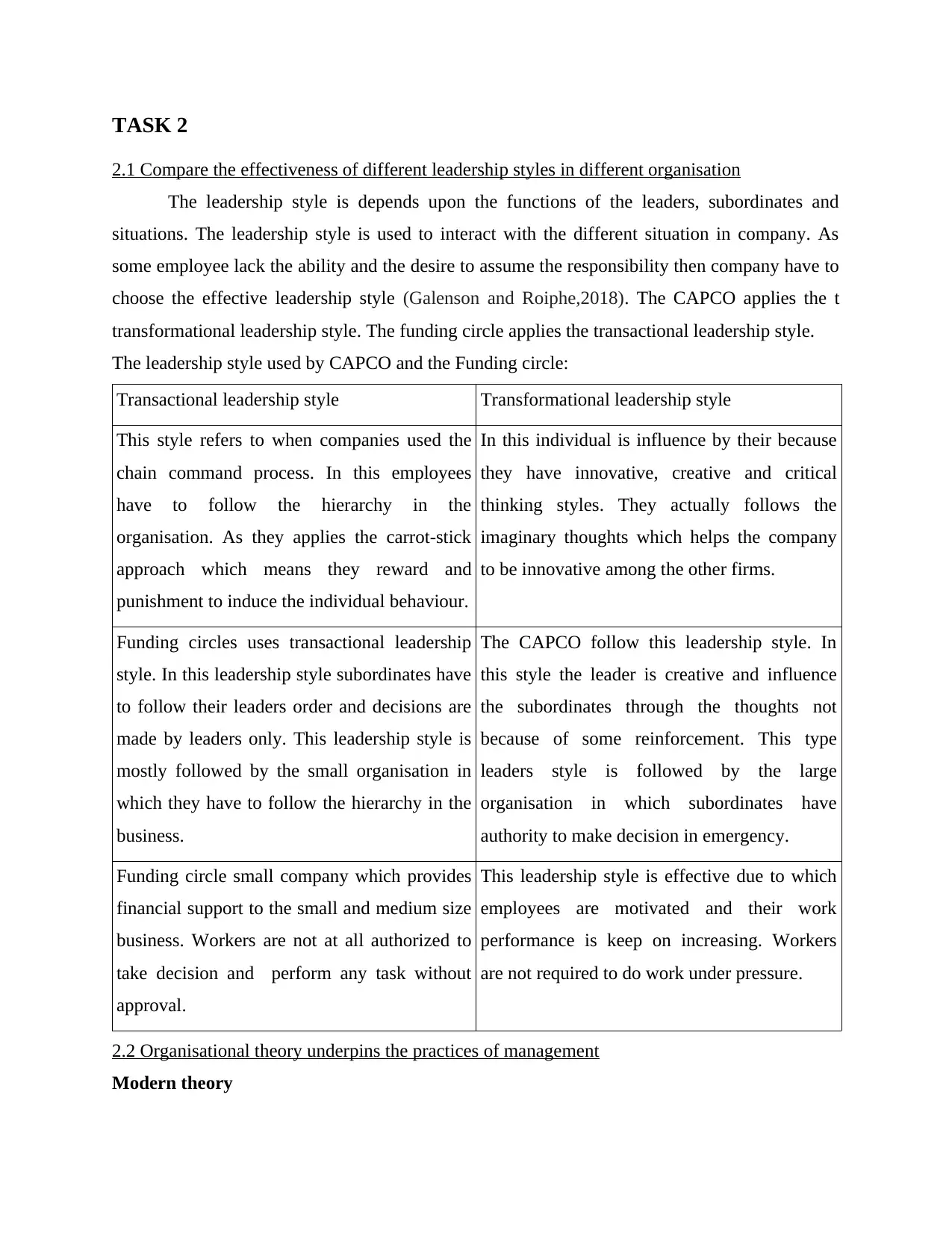
TASK 2
2.1 Compare the effectiveness of different leadership styles in different organisation
The leadership style is depends upon the functions of the leaders, subordinates and
situations. The leadership style is used to interact with the different situation in company. As
some employee lack the ability and the desire to assume the responsibility then company have to
choose the effective leadership style (Galenson and Roiphe,2018). The CAPCO applies the t
transformational leadership style. The funding circle applies the transactional leadership style.
The leadership style used by CAPCO and the Funding circle:
Transactional leadership style Transformational leadership style
This style refers to when companies used the
chain command process. In this employees
have to follow the hierarchy in the
organisation. As they applies the carrot-stick
approach which means they reward and
punishment to induce the individual behaviour.
In this individual is influence by their because
they have innovative, creative and critical
thinking styles. They actually follows the
imaginary thoughts which helps the company
to be innovative among the other firms.
Funding circles uses transactional leadership
style. In this leadership style subordinates have
to follow their leaders order and decisions are
made by leaders only. This leadership style is
mostly followed by the small organisation in
which they have to follow the hierarchy in the
business.
The CAPCO follow this leadership style. In
this style the leader is creative and influence
the subordinates through the thoughts not
because of some reinforcement. This type
leaders style is followed by the large
organisation in which subordinates have
authority to make decision in emergency.
Funding circle small company which provides
financial support to the small and medium size
business. Workers are not at all authorized to
take decision and perform any task without
approval.
This leadership style is effective due to which
employees are motivated and their work
performance is keep on increasing. Workers
are not required to do work under pressure.
2.2 Organisational theory underpins the practices of management
Modern theory
2.1 Compare the effectiveness of different leadership styles in different organisation
The leadership style is depends upon the functions of the leaders, subordinates and
situations. The leadership style is used to interact with the different situation in company. As
some employee lack the ability and the desire to assume the responsibility then company have to
choose the effective leadership style (Galenson and Roiphe,2018). The CAPCO applies the t
transformational leadership style. The funding circle applies the transactional leadership style.
The leadership style used by CAPCO and the Funding circle:
Transactional leadership style Transformational leadership style
This style refers to when companies used the
chain command process. In this employees
have to follow the hierarchy in the
organisation. As they applies the carrot-stick
approach which means they reward and
punishment to induce the individual behaviour.
In this individual is influence by their because
they have innovative, creative and critical
thinking styles. They actually follows the
imaginary thoughts which helps the company
to be innovative among the other firms.
Funding circles uses transactional leadership
style. In this leadership style subordinates have
to follow their leaders order and decisions are
made by leaders only. This leadership style is
mostly followed by the small organisation in
which they have to follow the hierarchy in the
business.
The CAPCO follow this leadership style. In
this style the leader is creative and influence
the subordinates through the thoughts not
because of some reinforcement. This type
leaders style is followed by the large
organisation in which subordinates have
authority to make decision in emergency.
Funding circle small company which provides
financial support to the small and medium size
business. Workers are not at all authorized to
take decision and perform any task without
approval.
This leadership style is effective due to which
employees are motivated and their work
performance is keep on increasing. Workers
are not required to do work under pressure.
2.2 Organisational theory underpins the practices of management
Modern theory
Paraphrase This Document
Need a fresh take? Get an instant paraphrase of this document with our AI Paraphraser
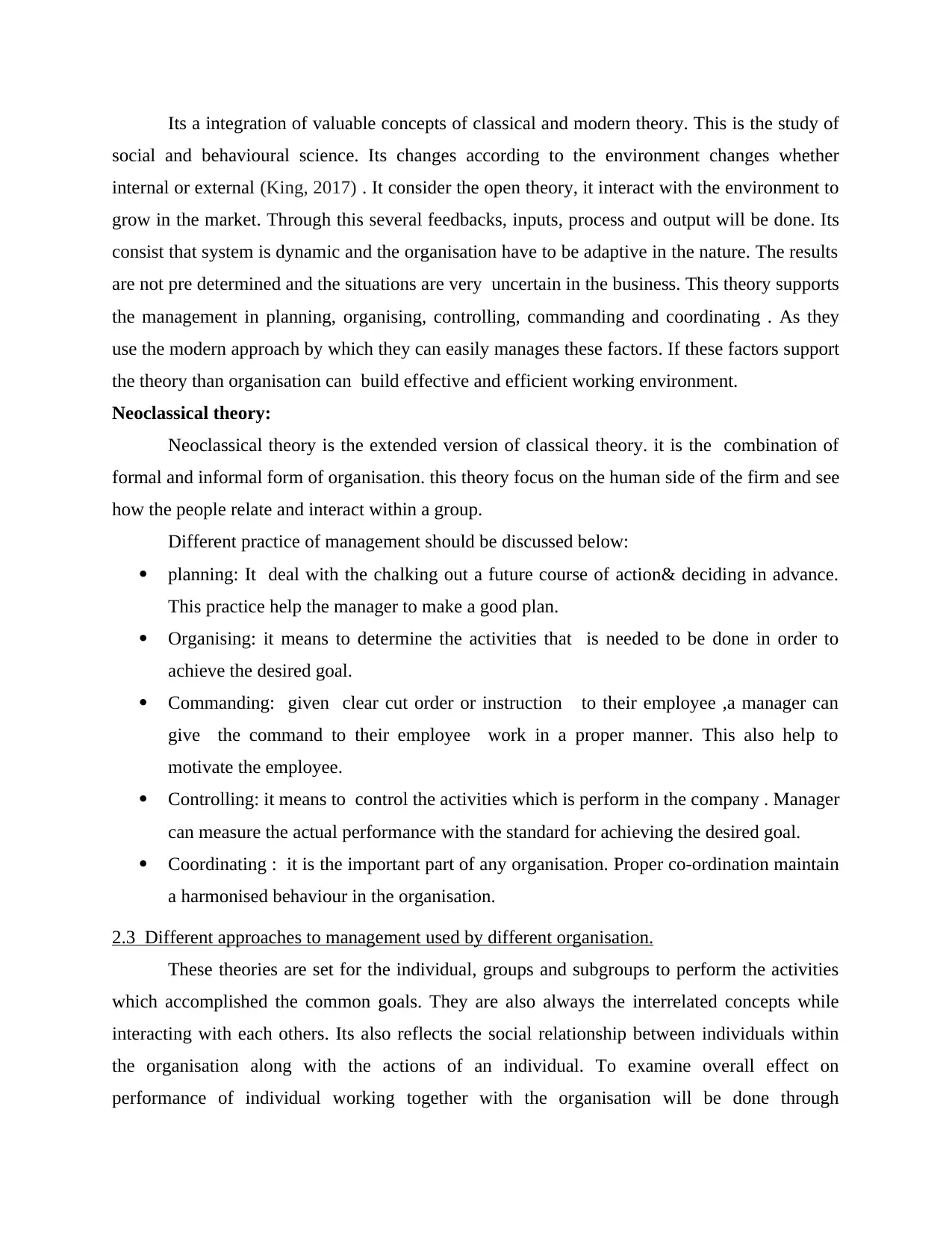
Its a integration of valuable concepts of classical and modern theory. This is the study of
social and behavioural science. Its changes according to the environment changes whether
internal or external (King, 2017) . It consider the open theory, it interact with the environment to
grow in the market. Through this several feedbacks, inputs, process and output will be done. Its
consist that system is dynamic and the organisation have to be adaptive in the nature. The results
are not pre determined and the situations are very uncertain in the business. This theory supports
the management in planning, organising, controlling, commanding and coordinating . As they
use the modern approach by which they can easily manages these factors. If these factors support
the theory than organisation can build effective and efficient working environment.
Neoclassical theory:
Neoclassical theory is the extended version of classical theory. it is the combination of
formal and informal form of organisation. this theory focus on the human side of the firm and see
how the people relate and interact within a group.
Different practice of management should be discussed below:
planning: It deal with the chalking out a future course of action& deciding in advance.
This practice help the manager to make a good plan.
Organising: it means to determine the activities that is needed to be done in order to
achieve the desired goal.
Commanding: given clear cut order or instruction to their employee ,a manager can
give the command to their employee work in a proper manner. This also help to
motivate the employee.
Controlling: it means to control the activities which is perform in the company . Manager
can measure the actual performance with the standard for achieving the desired goal.
Coordinating : it is the important part of any organisation. Proper co-ordination maintain
a harmonised behaviour in the organisation.
2.3 Different approaches to management used by different organisation.
These theories are set for the individual, groups and subgroups to perform the activities
which accomplished the common goals. They are also always the interrelated concepts while
interacting with each others. Its also reflects the social relationship between individuals within
the organisation along with the actions of an individual. To examine overall effect on
performance of individual working together with the organisation will be done through
social and behavioural science. Its changes according to the environment changes whether
internal or external (King, 2017) . It consider the open theory, it interact with the environment to
grow in the market. Through this several feedbacks, inputs, process and output will be done. Its
consist that system is dynamic and the organisation have to be adaptive in the nature. The results
are not pre determined and the situations are very uncertain in the business. This theory supports
the management in planning, organising, controlling, commanding and coordinating . As they
use the modern approach by which they can easily manages these factors. If these factors support
the theory than organisation can build effective and efficient working environment.
Neoclassical theory:
Neoclassical theory is the extended version of classical theory. it is the combination of
formal and informal form of organisation. this theory focus on the human side of the firm and see
how the people relate and interact within a group.
Different practice of management should be discussed below:
planning: It deal with the chalking out a future course of action& deciding in advance.
This practice help the manager to make a good plan.
Organising: it means to determine the activities that is needed to be done in order to
achieve the desired goal.
Commanding: given clear cut order or instruction to their employee ,a manager can
give the command to their employee work in a proper manner. This also help to
motivate the employee.
Controlling: it means to control the activities which is perform in the company . Manager
can measure the actual performance with the standard for achieving the desired goal.
Coordinating : it is the important part of any organisation. Proper co-ordination maintain
a harmonised behaviour in the organisation.
2.3 Different approaches to management used by different organisation.
These theories are set for the individual, groups and subgroups to perform the activities
which accomplished the common goals. They are also always the interrelated concepts while
interacting with each others. Its also reflects the social relationship between individuals within
the organisation along with the actions of an individual. To examine overall effect on
performance of individual working together with the organisation will be done through
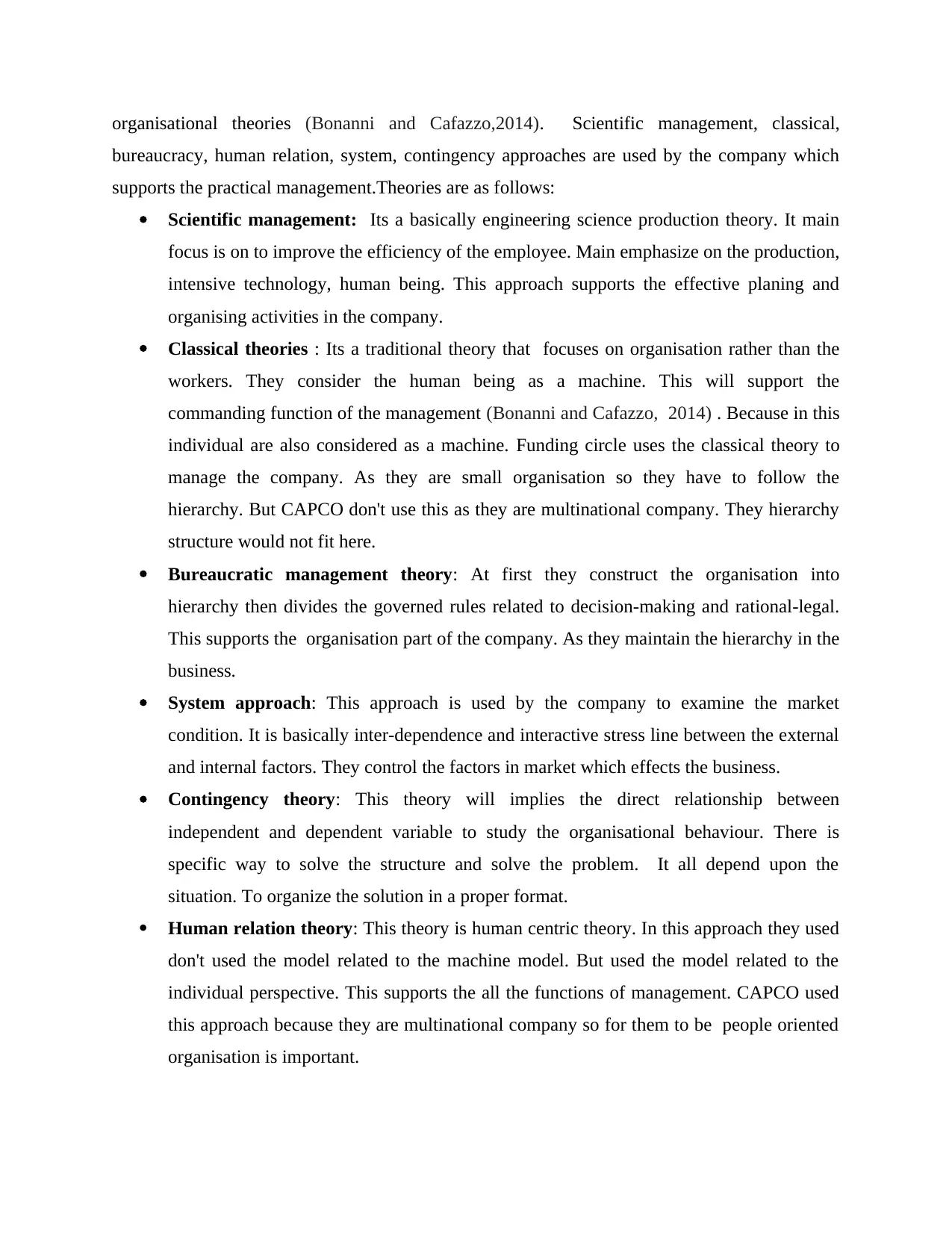
organisational theories (Bonanni and Cafazzo,2014). Scientific management, classical,
bureaucracy, human relation, system, contingency approaches are used by the company which
supports the practical management.Theories are as follows:
Scientific management: Its a basically engineering science production theory. It main
focus is on to improve the efficiency of the employee. Main emphasize on the production,
intensive technology, human being. This approach supports the effective planing and
organising activities in the company.
Classical theories : Its a traditional theory that focuses on organisation rather than the
workers. They consider the human being as a machine. This will support the
commanding function of the management (Bonanni and Cafazzo, 2014) . Because in this
individual are also considered as a machine. Funding circle uses the classical theory to
manage the company. As they are small organisation so they have to follow the
hierarchy. But CAPCO don't use this as they are multinational company. They hierarchy
structure would not fit here.
Bureaucratic management theory: At first they construct the organisation into
hierarchy then divides the governed rules related to decision-making and rational-legal.
This supports the organisation part of the company. As they maintain the hierarchy in the
business.
System approach: This approach is used by the company to examine the market
condition. It is basically inter-dependence and interactive stress line between the external
and internal factors. They control the factors in market which effects the business.
Contingency theory: This theory will implies the direct relationship between
independent and dependent variable to study the organisational behaviour. There is
specific way to solve the structure and solve the problem. It all depend upon the
situation. To organize the solution in a proper format.
Human relation theory: This theory is human centric theory. In this approach they used
don't used the model related to the machine model. But used the model related to the
individual perspective. This supports the all the functions of management. CAPCO used
this approach because they are multinational company so for them to be people oriented
organisation is important.
bureaucracy, human relation, system, contingency approaches are used by the company which
supports the practical management.Theories are as follows:
Scientific management: Its a basically engineering science production theory. It main
focus is on to improve the efficiency of the employee. Main emphasize on the production,
intensive technology, human being. This approach supports the effective planing and
organising activities in the company.
Classical theories : Its a traditional theory that focuses on organisation rather than the
workers. They consider the human being as a machine. This will support the
commanding function of the management (Bonanni and Cafazzo, 2014) . Because in this
individual are also considered as a machine. Funding circle uses the classical theory to
manage the company. As they are small organisation so they have to follow the
hierarchy. But CAPCO don't use this as they are multinational company. They hierarchy
structure would not fit here.
Bureaucratic management theory: At first they construct the organisation into
hierarchy then divides the governed rules related to decision-making and rational-legal.
This supports the organisation part of the company. As they maintain the hierarchy in the
business.
System approach: This approach is used by the company to examine the market
condition. It is basically inter-dependence and interactive stress line between the external
and internal factors. They control the factors in market which effects the business.
Contingency theory: This theory will implies the direct relationship between
independent and dependent variable to study the organisational behaviour. There is
specific way to solve the structure and solve the problem. It all depend upon the
situation. To organize the solution in a proper format.
Human relation theory: This theory is human centric theory. In this approach they used
don't used the model related to the machine model. But used the model related to the
individual perspective. This supports the all the functions of management. CAPCO used
this approach because they are multinational company so for them to be people oriented
organisation is important.
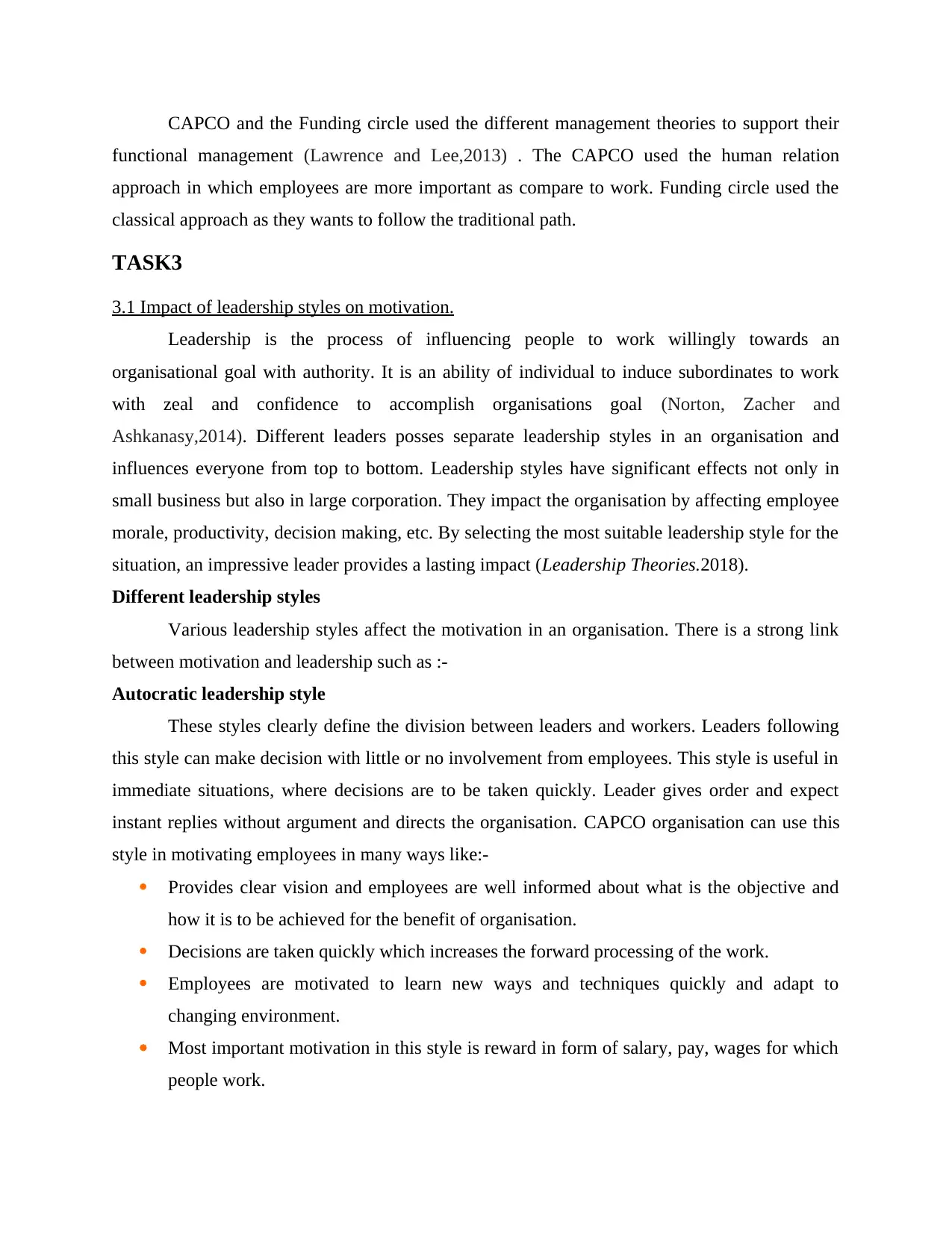
CAPCO and the Funding circle used the different management theories to support their
functional management (Lawrence and Lee,2013) . The CAPCO used the human relation
approach in which employees are more important as compare to work. Funding circle used the
classical approach as they wants to follow the traditional path.
TASK3
3.1 Impact of leadership styles on motivation.
Leadership is the process of influencing people to work willingly towards an
organisational goal with authority. It is an ability of individual to induce subordinates to work
with zeal and confidence to accomplish organisations goal (Norton, Zacher and
Ashkanasy,2014). Different leaders posses separate leadership styles in an organisation and
influences everyone from top to bottom. Leadership styles have significant effects not only in
small business but also in large corporation. They impact the organisation by affecting employee
morale, productivity, decision making, etc. By selecting the most suitable leadership style for the
situation, an impressive leader provides a lasting impact (Leadership Theories.2018).
Different leadership styles
Various leadership styles affect the motivation in an organisation. There is a strong link
between motivation and leadership such as :-
Autocratic leadership style
These styles clearly define the division between leaders and workers. Leaders following
this style can make decision with little or no involvement from employees. This style is useful in
immediate situations, where decisions are to be taken quickly. Leader gives order and expect
instant replies without argument and directs the organisation. CAPCO organisation can use this
style in motivating employees in many ways like:-
Provides clear vision and employees are well informed about what is the objective and
how it is to be achieved for the benefit of organisation.
Decisions are taken quickly which increases the forward processing of the work.
Employees are motivated to learn new ways and techniques quickly and adapt to
changing environment.
Most important motivation in this style is reward in form of salary, pay, wages for which
people work.
functional management (Lawrence and Lee,2013) . The CAPCO used the human relation
approach in which employees are more important as compare to work. Funding circle used the
classical approach as they wants to follow the traditional path.
TASK3
3.1 Impact of leadership styles on motivation.
Leadership is the process of influencing people to work willingly towards an
organisational goal with authority. It is an ability of individual to induce subordinates to work
with zeal and confidence to accomplish organisations goal (Norton, Zacher and
Ashkanasy,2014). Different leaders posses separate leadership styles in an organisation and
influences everyone from top to bottom. Leadership styles have significant effects not only in
small business but also in large corporation. They impact the organisation by affecting employee
morale, productivity, decision making, etc. By selecting the most suitable leadership style for the
situation, an impressive leader provides a lasting impact (Leadership Theories.2018).
Different leadership styles
Various leadership styles affect the motivation in an organisation. There is a strong link
between motivation and leadership such as :-
Autocratic leadership style
These styles clearly define the division between leaders and workers. Leaders following
this style can make decision with little or no involvement from employees. This style is useful in
immediate situations, where decisions are to be taken quickly. Leader gives order and expect
instant replies without argument and directs the organisation. CAPCO organisation can use this
style in motivating employees in many ways like:-
Provides clear vision and employees are well informed about what is the objective and
how it is to be achieved for the benefit of organisation.
Decisions are taken quickly which increases the forward processing of the work.
Employees are motivated to learn new ways and techniques quickly and adapt to
changing environment.
Most important motivation in this style is reward in form of salary, pay, wages for which
people work.
Secure Best Marks with AI Grader
Need help grading? Try our AI Grader for instant feedback on your assignments.
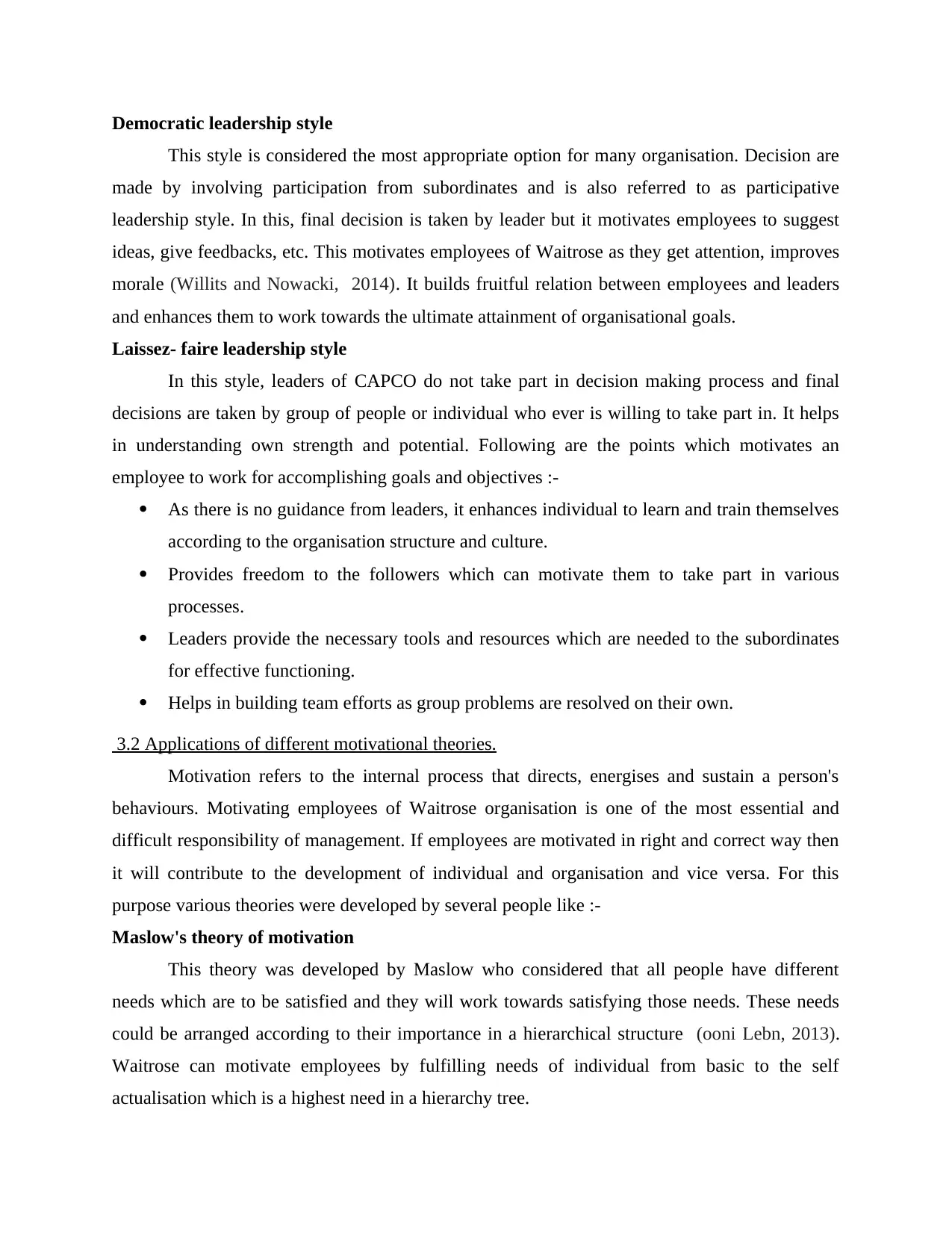
Democratic leadership style
This style is considered the most appropriate option for many organisation. Decision are
made by involving participation from subordinates and is also referred to as participative
leadership style. In this, final decision is taken by leader but it motivates employees to suggest
ideas, give feedbacks, etc. This motivates employees of Waitrose as they get attention, improves
morale (Willits and Nowacki, 2014). It builds fruitful relation between employees and leaders
and enhances them to work towards the ultimate attainment of organisational goals.
Laissez- faire leadership style
In this style, leaders of CAPCO do not take part in decision making process and final
decisions are taken by group of people or individual who ever is willing to take part in. It helps
in understanding own strength and potential. Following are the points which motivates an
employee to work for accomplishing goals and objectives :-
As there is no guidance from leaders, it enhances individual to learn and train themselves
according to the organisation structure and culture.
Provides freedom to the followers which can motivate them to take part in various
processes.
Leaders provide the necessary tools and resources which are needed to the subordinates
for effective functioning.
Helps in building team efforts as group problems are resolved on their own.
3.2 Applications of different motivational theories.
Motivation refers to the internal process that directs, energises and sustain a person's
behaviours. Motivating employees of Waitrose organisation is one of the most essential and
difficult responsibility of management. If employees are motivated in right and correct way then
it will contribute to the development of individual and organisation and vice versa. For this
purpose various theories were developed by several people like :-
Maslow's theory of motivation
This theory was developed by Maslow who considered that all people have different
needs which are to be satisfied and they will work towards satisfying those needs. These needs
could be arranged according to their importance in a hierarchical structure (ooni Lebn, 2013).
Waitrose can motivate employees by fulfilling needs of individual from basic to the self
actualisation which is a highest need in a hierarchy tree.
This style is considered the most appropriate option for many organisation. Decision are
made by involving participation from subordinates and is also referred to as participative
leadership style. In this, final decision is taken by leader but it motivates employees to suggest
ideas, give feedbacks, etc. This motivates employees of Waitrose as they get attention, improves
morale (Willits and Nowacki, 2014). It builds fruitful relation between employees and leaders
and enhances them to work towards the ultimate attainment of organisational goals.
Laissez- faire leadership style
In this style, leaders of CAPCO do not take part in decision making process and final
decisions are taken by group of people or individual who ever is willing to take part in. It helps
in understanding own strength and potential. Following are the points which motivates an
employee to work for accomplishing goals and objectives :-
As there is no guidance from leaders, it enhances individual to learn and train themselves
according to the organisation structure and culture.
Provides freedom to the followers which can motivate them to take part in various
processes.
Leaders provide the necessary tools and resources which are needed to the subordinates
for effective functioning.
Helps in building team efforts as group problems are resolved on their own.
3.2 Applications of different motivational theories.
Motivation refers to the internal process that directs, energises and sustain a person's
behaviours. Motivating employees of Waitrose organisation is one of the most essential and
difficult responsibility of management. If employees are motivated in right and correct way then
it will contribute to the development of individual and organisation and vice versa. For this
purpose various theories were developed by several people like :-
Maslow's theory of motivation
This theory was developed by Maslow who considered that all people have different
needs which are to be satisfied and they will work towards satisfying those needs. These needs
could be arranged according to their importance in a hierarchical structure (ooni Lebn, 2013).
Waitrose can motivate employees by fulfilling needs of individual from basic to the self
actualisation which is a highest need in a hierarchy tree.
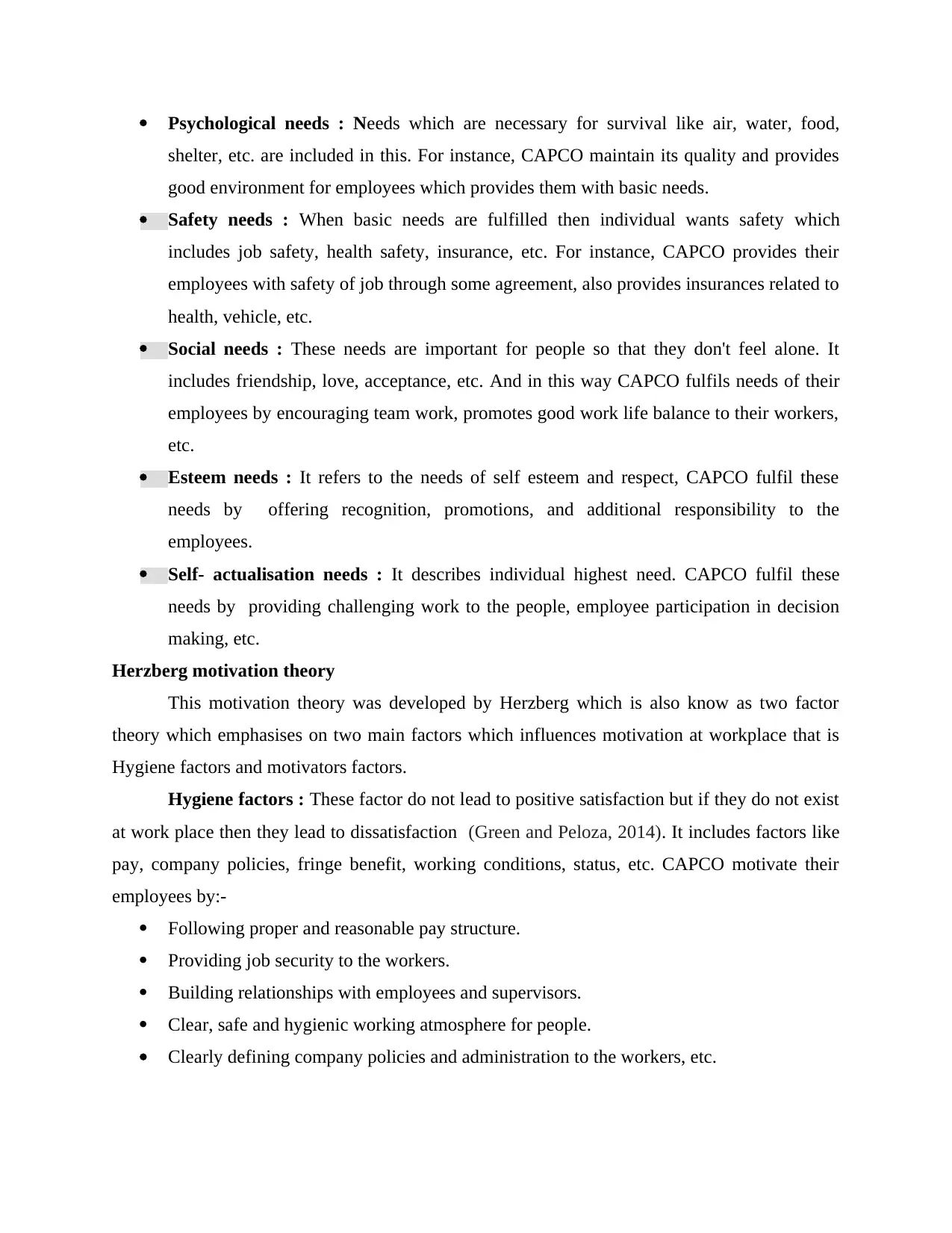
Psychological needs : Needs which are necessary for survival like air, water, food,
shelter, etc. are included in this. For instance, CAPCO maintain its quality and provides
good environment for employees which provides them with basic needs.
Safety needs : When basic needs are fulfilled then individual wants safety which
includes job safety, health safety, insurance, etc. For instance, CAPCO provides their
employees with safety of job through some agreement, also provides insurances related to
health, vehicle, etc.
Social needs : These needs are important for people so that they don't feel alone. It
includes friendship, love, acceptance, etc. And in this way CAPCO fulfils needs of their
employees by encouraging team work, promotes good work life balance to their workers,
etc.
Esteem needs : It refers to the needs of self esteem and respect, CAPCO fulfil these
needs by offering recognition, promotions, and additional responsibility to the
employees.
Self- actualisation needs : It describes individual highest need. CAPCO fulfil these
needs by providing challenging work to the people, employee participation in decision
making, etc.
Herzberg motivation theory
This motivation theory was developed by Herzberg which is also know as two factor
theory which emphasises on two main factors which influences motivation at workplace that is
Hygiene factors and motivators factors.
Hygiene factors : These factor do not lead to positive satisfaction but if they do not exist
at work place then they lead to dissatisfaction (Green and Peloza, 2014). It includes factors like
pay, company policies, fringe benefit, working conditions, status, etc. CAPCO motivate their
employees by:-
Following proper and reasonable pay structure.
Providing job security to the workers.
Building relationships with employees and supervisors.
Clear, safe and hygienic working atmosphere for people.
Clearly defining company policies and administration to the workers, etc.
shelter, etc. are included in this. For instance, CAPCO maintain its quality and provides
good environment for employees which provides them with basic needs.
Safety needs : When basic needs are fulfilled then individual wants safety which
includes job safety, health safety, insurance, etc. For instance, CAPCO provides their
employees with safety of job through some agreement, also provides insurances related to
health, vehicle, etc.
Social needs : These needs are important for people so that they don't feel alone. It
includes friendship, love, acceptance, etc. And in this way CAPCO fulfils needs of their
employees by encouraging team work, promotes good work life balance to their workers,
etc.
Esteem needs : It refers to the needs of self esteem and respect, CAPCO fulfil these
needs by offering recognition, promotions, and additional responsibility to the
employees.
Self- actualisation needs : It describes individual highest need. CAPCO fulfil these
needs by providing challenging work to the people, employee participation in decision
making, etc.
Herzberg motivation theory
This motivation theory was developed by Herzberg which is also know as two factor
theory which emphasises on two main factors which influences motivation at workplace that is
Hygiene factors and motivators factors.
Hygiene factors : These factor do not lead to positive satisfaction but if they do not exist
at work place then they lead to dissatisfaction (Green and Peloza, 2014). It includes factors like
pay, company policies, fringe benefit, working conditions, status, etc. CAPCO motivate their
employees by:-
Following proper and reasonable pay structure.
Providing job security to the workers.
Building relationships with employees and supervisors.
Clear, safe and hygienic working atmosphere for people.
Clearly defining company policies and administration to the workers, etc.
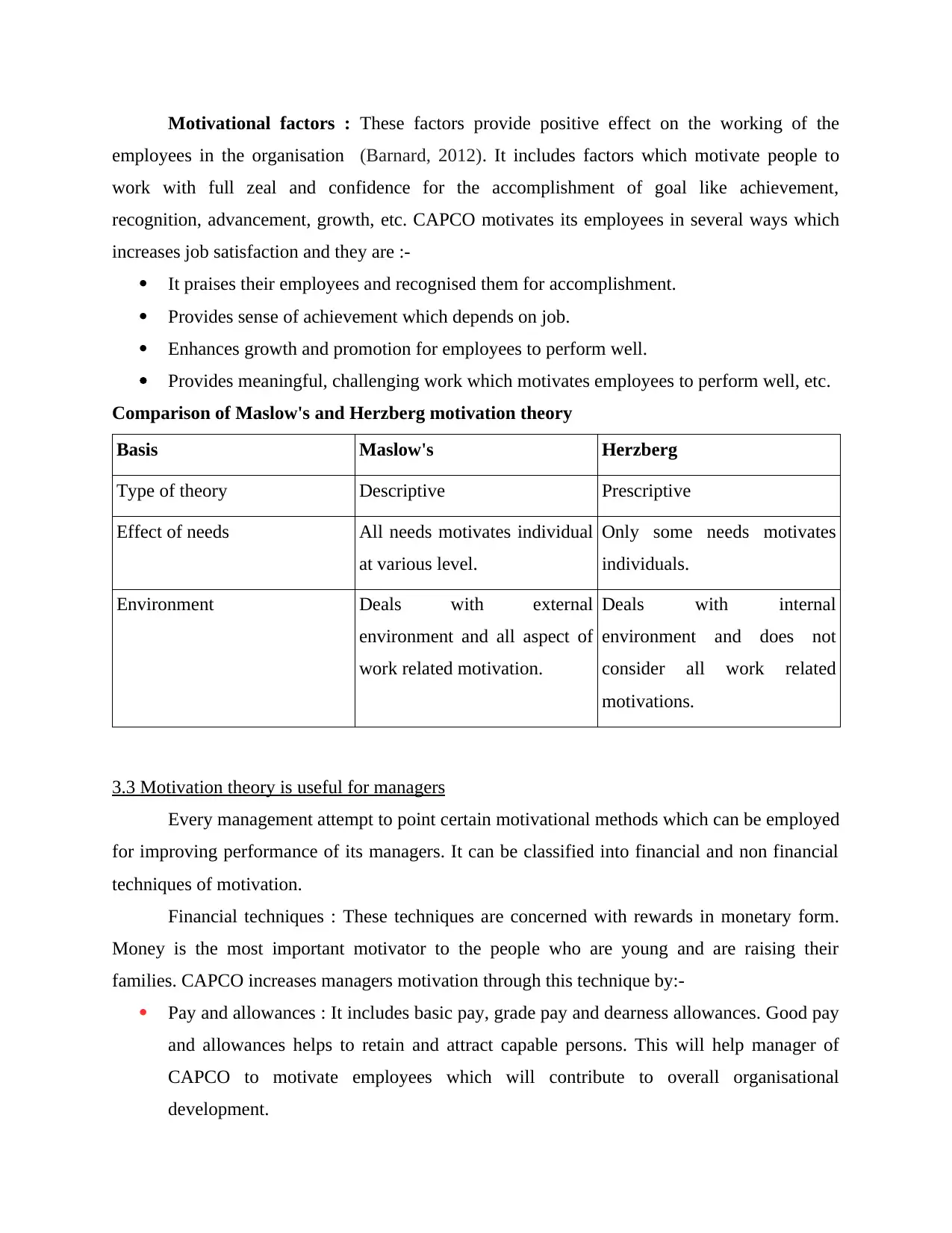
Motivational factors : These factors provide positive effect on the working of the
employees in the organisation (Barnard, 2012). It includes factors which motivate people to
work with full zeal and confidence for the accomplishment of goal like achievement,
recognition, advancement, growth, etc. CAPCO motivates its employees in several ways which
increases job satisfaction and they are :-
It praises their employees and recognised them for accomplishment.
Provides sense of achievement which depends on job.
Enhances growth and promotion for employees to perform well.
Provides meaningful, challenging work which motivates employees to perform well, etc.
Comparison of Maslow's and Herzberg motivation theory
Basis Maslow's Herzberg
Type of theory Descriptive Prescriptive
Effect of needs All needs motivates individual
at various level.
Only some needs motivates
individuals.
Environment Deals with external
environment and all aspect of
work related motivation.
Deals with internal
environment and does not
consider all work related
motivations.
3.3 Motivation theory is useful for managers
Every management attempt to point certain motivational methods which can be employed
for improving performance of its managers. It can be classified into financial and non financial
techniques of motivation.
Financial techniques : These techniques are concerned with rewards in monetary form.
Money is the most important motivator to the people who are young and are raising their
families. CAPCO increases managers motivation through this technique by:-
Pay and allowances : It includes basic pay, grade pay and dearness allowances. Good pay
and allowances helps to retain and attract capable persons. This will help manager of
CAPCO to motivate employees which will contribute to overall organisational
development.
employees in the organisation (Barnard, 2012). It includes factors which motivate people to
work with full zeal and confidence for the accomplishment of goal like achievement,
recognition, advancement, growth, etc. CAPCO motivates its employees in several ways which
increases job satisfaction and they are :-
It praises their employees and recognised them for accomplishment.
Provides sense of achievement which depends on job.
Enhances growth and promotion for employees to perform well.
Provides meaningful, challenging work which motivates employees to perform well, etc.
Comparison of Maslow's and Herzberg motivation theory
Basis Maslow's Herzberg
Type of theory Descriptive Prescriptive
Effect of needs All needs motivates individual
at various level.
Only some needs motivates
individuals.
Environment Deals with external
environment and all aspect of
work related motivation.
Deals with internal
environment and does not
consider all work related
motivations.
3.3 Motivation theory is useful for managers
Every management attempt to point certain motivational methods which can be employed
for improving performance of its managers. It can be classified into financial and non financial
techniques of motivation.
Financial techniques : These techniques are concerned with rewards in monetary form.
Money is the most important motivator to the people who are young and are raising their
families. CAPCO increases managers motivation through this technique by:-
Pay and allowances : It includes basic pay, grade pay and dearness allowances. Good pay
and allowances helps to retain and attract capable persons. This will help manager of
CAPCO to motivate employees which will contribute to overall organisational
development.
Paraphrase This Document
Need a fresh take? Get an instant paraphrase of this document with our AI Paraphraser
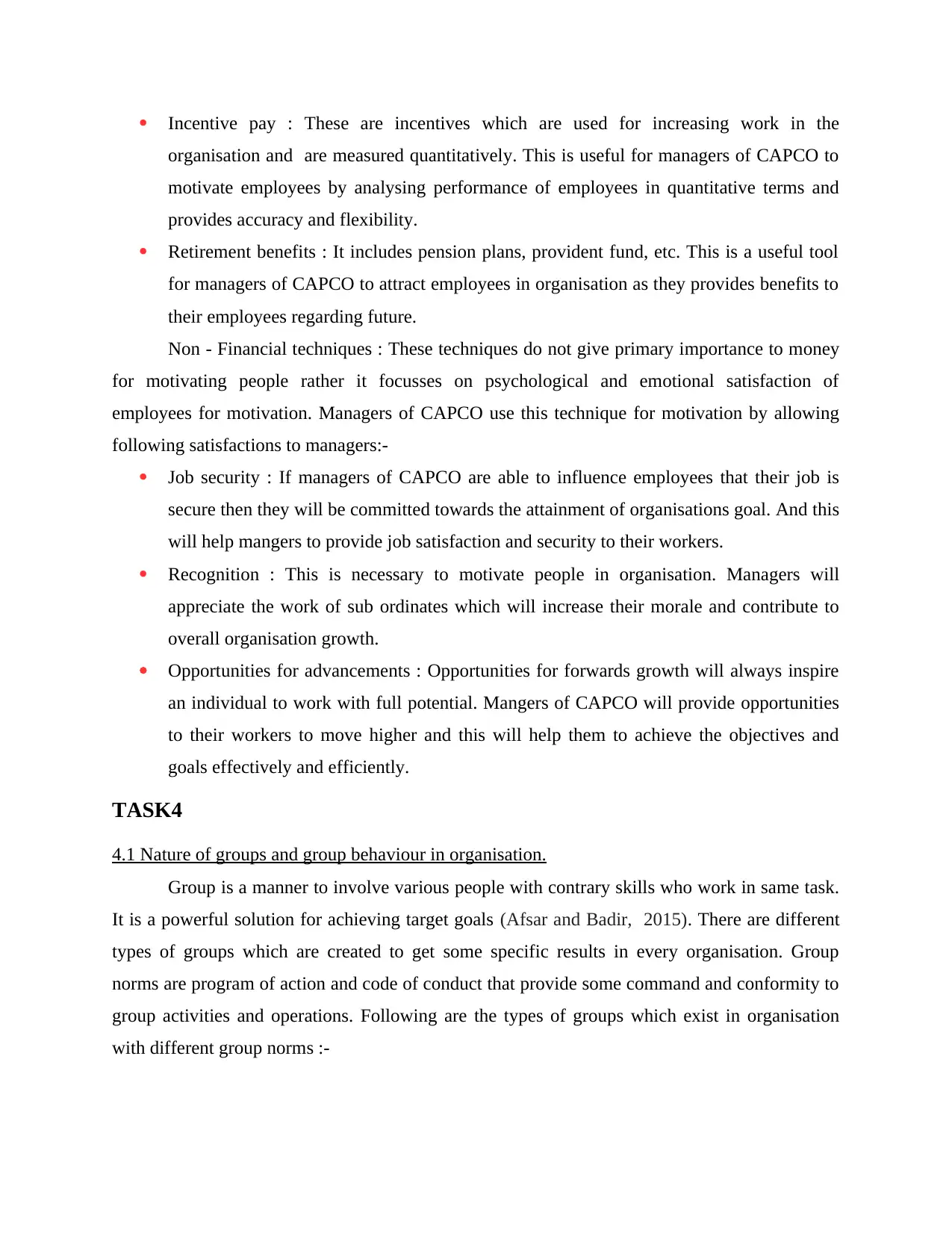
Incentive pay : These are incentives which are used for increasing work in the
organisation and are measured quantitatively. This is useful for managers of CAPCO to
motivate employees by analysing performance of employees in quantitative terms and
provides accuracy and flexibility.
Retirement benefits : It includes pension plans, provident fund, etc. This is a useful tool
for managers of CAPCO to attract employees in organisation as they provides benefits to
their employees regarding future.
Non - Financial techniques : These techniques do not give primary importance to money
for motivating people rather it focusses on psychological and emotional satisfaction of
employees for motivation. Managers of CAPCO use this technique for motivation by allowing
following satisfactions to managers:-
Job security : If managers of CAPCO are able to influence employees that their job is
secure then they will be committed towards the attainment of organisations goal. And this
will help mangers to provide job satisfaction and security to their workers.
Recognition : This is necessary to motivate people in organisation. Managers will
appreciate the work of sub ordinates which will increase their morale and contribute to
overall organisation growth.
Opportunities for advancements : Opportunities for forwards growth will always inspire
an individual to work with full potential. Mangers of CAPCO will provide opportunities
to their workers to move higher and this will help them to achieve the objectives and
goals effectively and efficiently.
TASK4
4.1 Nature of groups and group behaviour in organisation.
Group is a manner to involve various people with contrary skills who work in same task.
It is a powerful solution for achieving target goals (Afsar and Badir, 2015). There are different
types of groups which are created to get some specific results in every organisation. Group
norms are program of action and code of conduct that provide some command and conformity to
group activities and operations. Following are the types of groups which exist in organisation
with different group norms :-
organisation and are measured quantitatively. This is useful for managers of CAPCO to
motivate employees by analysing performance of employees in quantitative terms and
provides accuracy and flexibility.
Retirement benefits : It includes pension plans, provident fund, etc. This is a useful tool
for managers of CAPCO to attract employees in organisation as they provides benefits to
their employees regarding future.
Non - Financial techniques : These techniques do not give primary importance to money
for motivating people rather it focusses on psychological and emotional satisfaction of
employees for motivation. Managers of CAPCO use this technique for motivation by allowing
following satisfactions to managers:-
Job security : If managers of CAPCO are able to influence employees that their job is
secure then they will be committed towards the attainment of organisations goal. And this
will help mangers to provide job satisfaction and security to their workers.
Recognition : This is necessary to motivate people in organisation. Managers will
appreciate the work of sub ordinates which will increase their morale and contribute to
overall organisation growth.
Opportunities for advancements : Opportunities for forwards growth will always inspire
an individual to work with full potential. Mangers of CAPCO will provide opportunities
to their workers to move higher and this will help them to achieve the objectives and
goals effectively and efficiently.
TASK4
4.1 Nature of groups and group behaviour in organisation.
Group is a manner to involve various people with contrary skills who work in same task.
It is a powerful solution for achieving target goals (Afsar and Badir, 2015). There are different
types of groups which are created to get some specific results in every organisation. Group
norms are program of action and code of conduct that provide some command and conformity to
group activities and operations. Following are the types of groups which exist in organisation
with different group norms :-
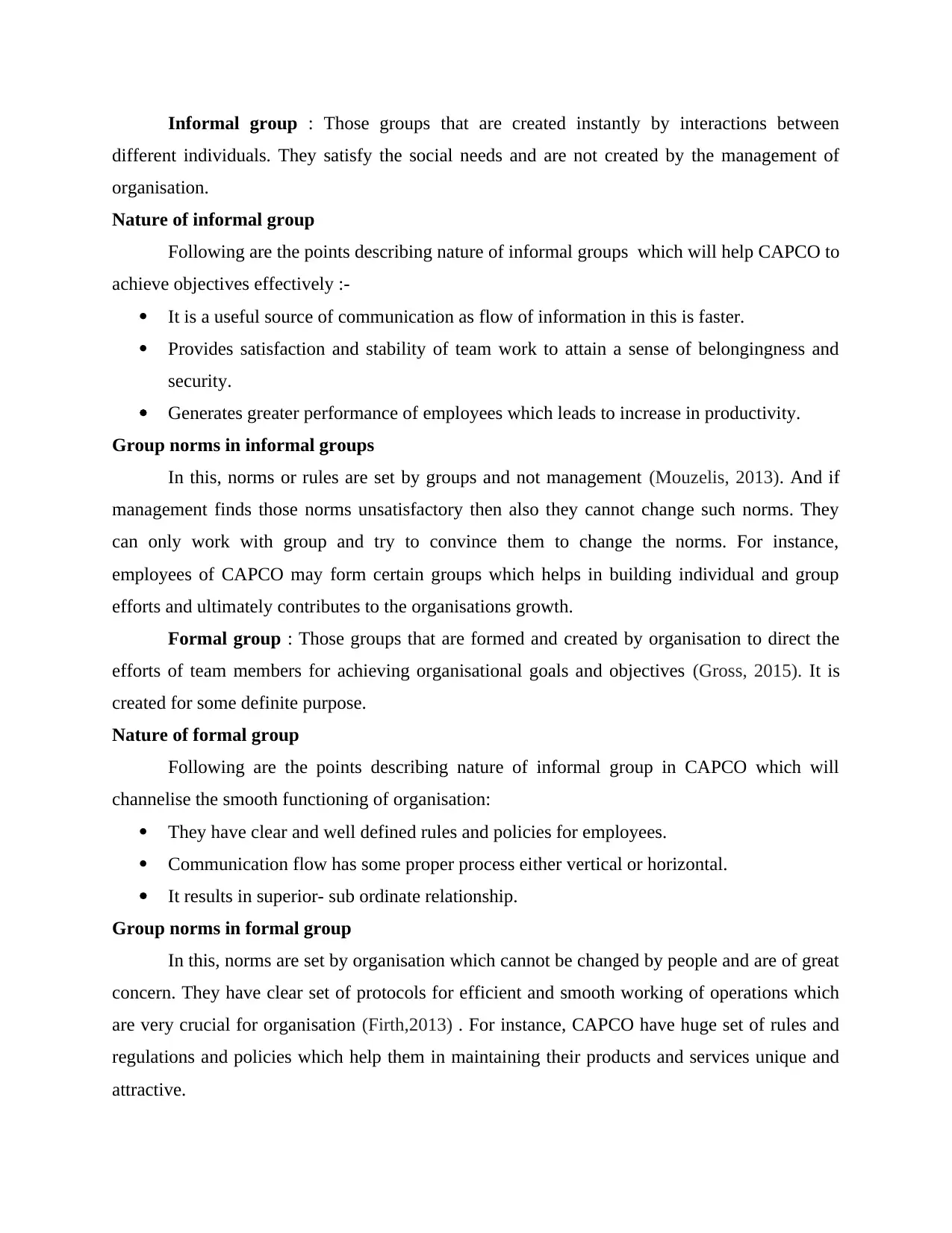
Informal group : Those groups that are created instantly by interactions between
different individuals. They satisfy the social needs and are not created by the management of
organisation.
Nature of informal group
Following are the points describing nature of informal groups which will help CAPCO to
achieve objectives effectively :-
It is a useful source of communication as flow of information in this is faster.
Provides satisfaction and stability of team work to attain a sense of belongingness and
security.
Generates greater performance of employees which leads to increase in productivity.
Group norms in informal groups
In this, norms or rules are set by groups and not management (Mouzelis, 2013). And if
management finds those norms unsatisfactory then also they cannot change such norms. They
can only work with group and try to convince them to change the norms. For instance,
employees of CAPCO may form certain groups which helps in building individual and group
efforts and ultimately contributes to the organisations growth.
Formal group : Those groups that are formed and created by organisation to direct the
efforts of team members for achieving organisational goals and objectives (Gross, 2015). It is
created for some definite purpose.
Nature of formal group
Following are the points describing nature of informal group in CAPCO which will
channelise the smooth functioning of organisation:
They have clear and well defined rules and policies for employees.
Communication flow has some proper process either vertical or horizontal.
It results in superior- sub ordinate relationship.
Group norms in formal group
In this, norms are set by organisation which cannot be changed by people and are of great
concern. They have clear set of protocols for efficient and smooth working of operations which
are very crucial for organisation (Firth,2013) . For instance, CAPCO have huge set of rules and
regulations and policies which help them in maintaining their products and services unique and
attractive.
different individuals. They satisfy the social needs and are not created by the management of
organisation.
Nature of informal group
Following are the points describing nature of informal groups which will help CAPCO to
achieve objectives effectively :-
It is a useful source of communication as flow of information in this is faster.
Provides satisfaction and stability of team work to attain a sense of belongingness and
security.
Generates greater performance of employees which leads to increase in productivity.
Group norms in informal groups
In this, norms or rules are set by groups and not management (Mouzelis, 2013). And if
management finds those norms unsatisfactory then also they cannot change such norms. They
can only work with group and try to convince them to change the norms. For instance,
employees of CAPCO may form certain groups which helps in building individual and group
efforts and ultimately contributes to the organisations growth.
Formal group : Those groups that are formed and created by organisation to direct the
efforts of team members for achieving organisational goals and objectives (Gross, 2015). It is
created for some definite purpose.
Nature of formal group
Following are the points describing nature of informal group in CAPCO which will
channelise the smooth functioning of organisation:
They have clear and well defined rules and policies for employees.
Communication flow has some proper process either vertical or horizontal.
It results in superior- sub ordinate relationship.
Group norms in formal group
In this, norms are set by organisation which cannot be changed by people and are of great
concern. They have clear set of protocols for efficient and smooth working of operations which
are very crucial for organisation (Firth,2013) . For instance, CAPCO have huge set of rules and
regulations and policies which help them in maintaining their products and services unique and
attractive.
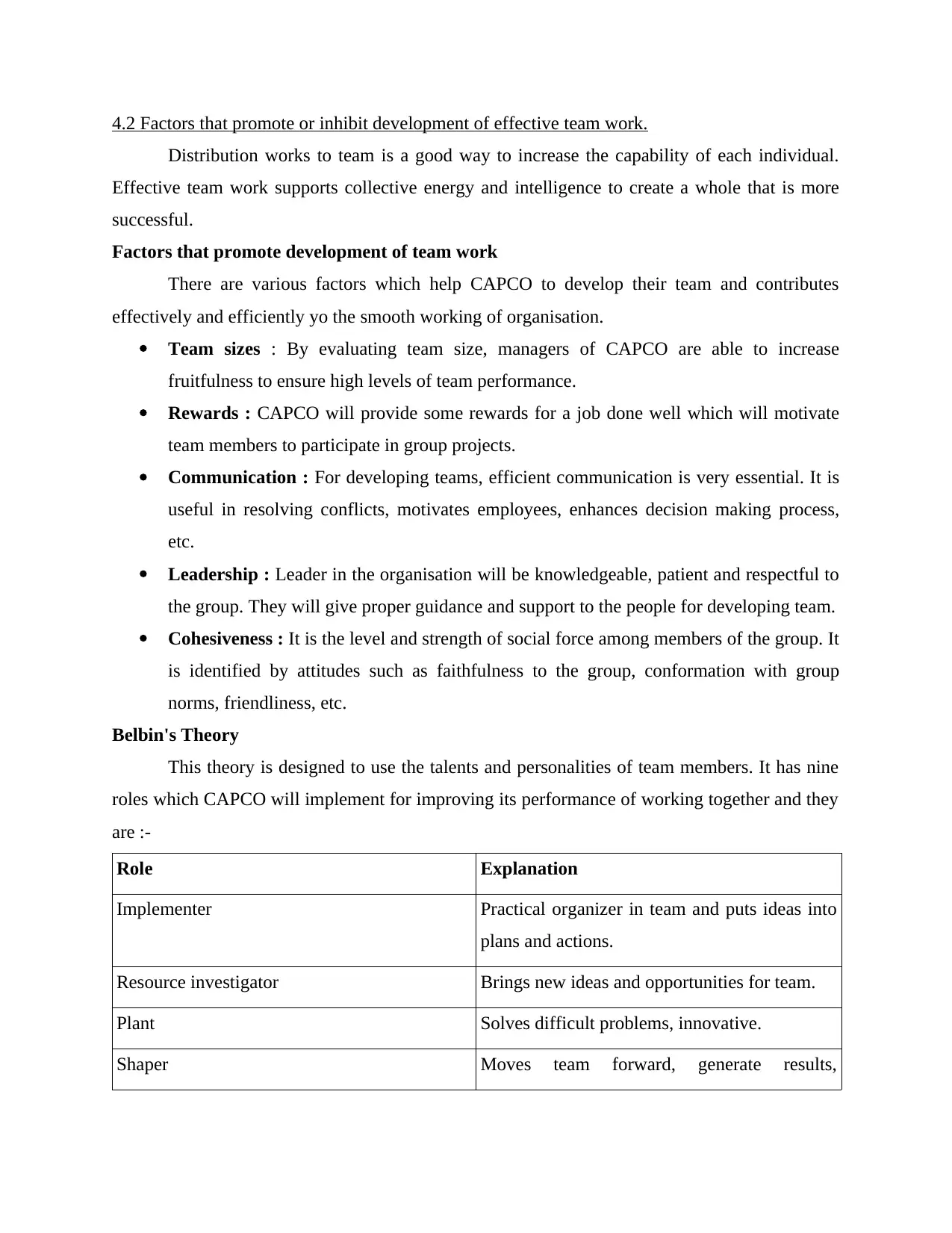
4.2 Factors that promote or inhibit development of effective team work.
Distribution works to team is a good way to increase the capability of each individual.
Effective team work supports collective energy and intelligence to create a whole that is more
successful.
Factors that promote development of team work
There are various factors which help CAPCO to develop their team and contributes
effectively and efficiently yo the smooth working of organisation.
Team sizes : By evaluating team size, managers of CAPCO are able to increase
fruitfulness to ensure high levels of team performance.
Rewards : CAPCO will provide some rewards for a job done well which will motivate
team members to participate in group projects.
Communication : For developing teams, efficient communication is very essential. It is
useful in resolving conflicts, motivates employees, enhances decision making process,
etc.
Leadership : Leader in the organisation will be knowledgeable, patient and respectful to
the group. They will give proper guidance and support to the people for developing team.
Cohesiveness : It is the level and strength of social force among members of the group. It
is identified by attitudes such as faithfulness to the group, conformation with group
norms, friendliness, etc.
Belbin's Theory
This theory is designed to use the talents and personalities of team members. It has nine
roles which CAPCO will implement for improving its performance of working together and they
are :-
Role Explanation
Implementer Practical organizer in team and puts ideas into
plans and actions.
Resource investigator Brings new ideas and opportunities for team.
Plant Solves difficult problems, innovative.
Shaper Moves team forward, generate results,
Distribution works to team is a good way to increase the capability of each individual.
Effective team work supports collective energy and intelligence to create a whole that is more
successful.
Factors that promote development of team work
There are various factors which help CAPCO to develop their team and contributes
effectively and efficiently yo the smooth working of organisation.
Team sizes : By evaluating team size, managers of CAPCO are able to increase
fruitfulness to ensure high levels of team performance.
Rewards : CAPCO will provide some rewards for a job done well which will motivate
team members to participate in group projects.
Communication : For developing teams, efficient communication is very essential. It is
useful in resolving conflicts, motivates employees, enhances decision making process,
etc.
Leadership : Leader in the organisation will be knowledgeable, patient and respectful to
the group. They will give proper guidance and support to the people for developing team.
Cohesiveness : It is the level and strength of social force among members of the group. It
is identified by attitudes such as faithfulness to the group, conformation with group
norms, friendliness, etc.
Belbin's Theory
This theory is designed to use the talents and personalities of team members. It has nine
roles which CAPCO will implement for improving its performance of working together and they
are :-
Role Explanation
Implementer Practical organizer in team and puts ideas into
plans and actions.
Resource investigator Brings new ideas and opportunities for team.
Plant Solves difficult problems, innovative.
Shaper Moves team forward, generate results,
Secure Best Marks with AI Grader
Need help grading? Try our AI Grader for instant feedback on your assignments.
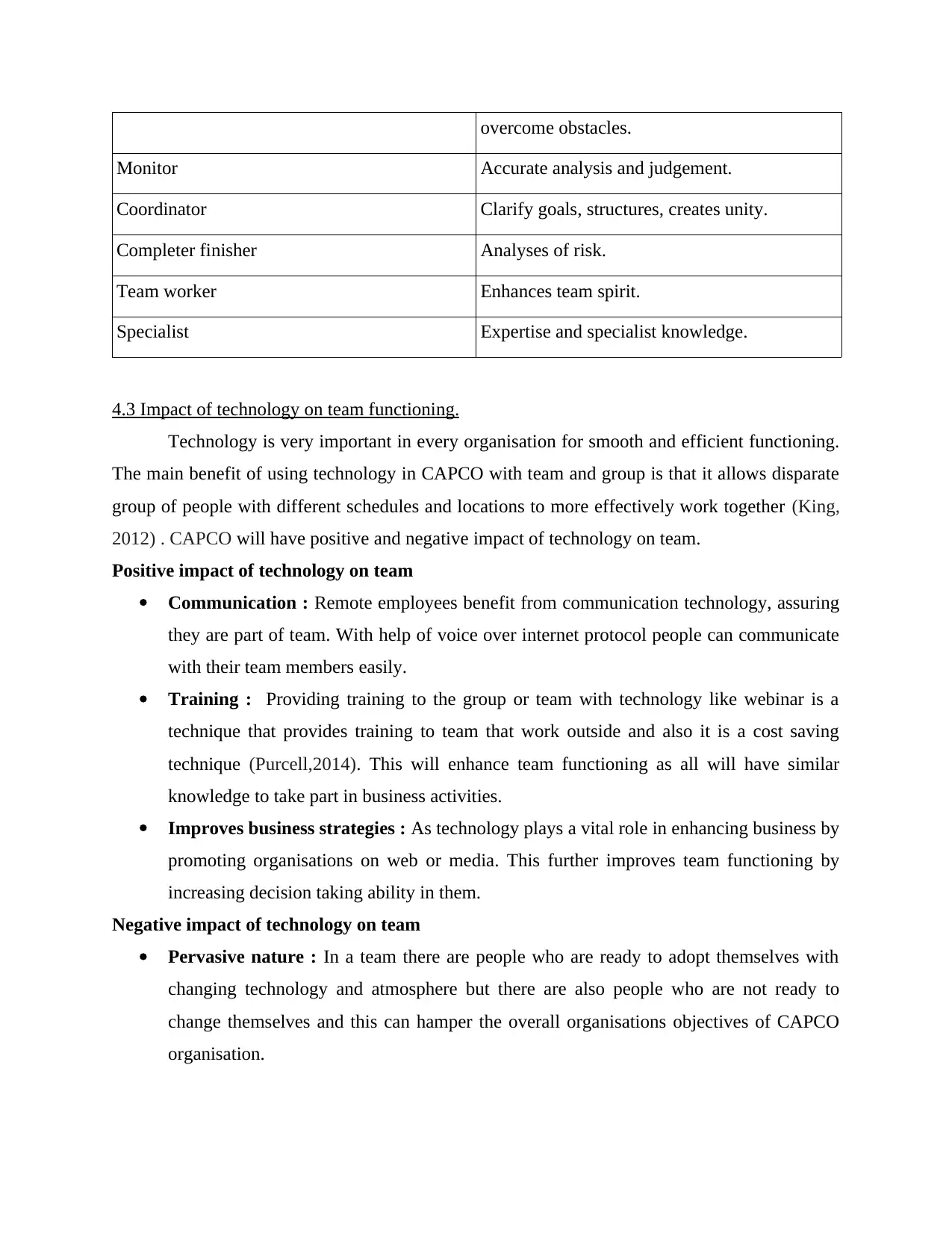
overcome obstacles.
Monitor Accurate analysis and judgement.
Coordinator Clarify goals, structures, creates unity.
Completer finisher Analyses of risk.
Team worker Enhances team spirit.
Specialist Expertise and specialist knowledge.
4.3 Impact of technology on team functioning.
Technology is very important in every organisation for smooth and efficient functioning.
The main benefit of using technology in CAPCO with team and group is that it allows disparate
group of people with different schedules and locations to more effectively work together (King,
2012) . CAPCO will have positive and negative impact of technology on team.
Positive impact of technology on team
Communication : Remote employees benefit from communication technology, assuring
they are part of team. With help of voice over internet protocol people can communicate
with their team members easily.
Training : Providing training to the group or team with technology like webinar is a
technique that provides training to team that work outside and also it is a cost saving
technique (Purcell,2014). This will enhance team functioning as all will have similar
knowledge to take part in business activities.
Improves business strategies : As technology plays a vital role in enhancing business by
promoting organisations on web or media. This further improves team functioning by
increasing decision taking ability in them.
Negative impact of technology on team
Pervasive nature : In a team there are people who are ready to adopt themselves with
changing technology and atmosphere but there are also people who are not ready to
change themselves and this can hamper the overall organisations objectives of CAPCO
organisation.
Monitor Accurate analysis and judgement.
Coordinator Clarify goals, structures, creates unity.
Completer finisher Analyses of risk.
Team worker Enhances team spirit.
Specialist Expertise and specialist knowledge.
4.3 Impact of technology on team functioning.
Technology is very important in every organisation for smooth and efficient functioning.
The main benefit of using technology in CAPCO with team and group is that it allows disparate
group of people with different schedules and locations to more effectively work together (King,
2012) . CAPCO will have positive and negative impact of technology on team.
Positive impact of technology on team
Communication : Remote employees benefit from communication technology, assuring
they are part of team. With help of voice over internet protocol people can communicate
with their team members easily.
Training : Providing training to the group or team with technology like webinar is a
technique that provides training to team that work outside and also it is a cost saving
technique (Purcell,2014). This will enhance team functioning as all will have similar
knowledge to take part in business activities.
Improves business strategies : As technology plays a vital role in enhancing business by
promoting organisations on web or media. This further improves team functioning by
increasing decision taking ability in them.
Negative impact of technology on team
Pervasive nature : In a team there are people who are ready to adopt themselves with
changing technology and atmosphere but there are also people who are not ready to
change themselves and this can hamper the overall organisations objectives of CAPCO
organisation.
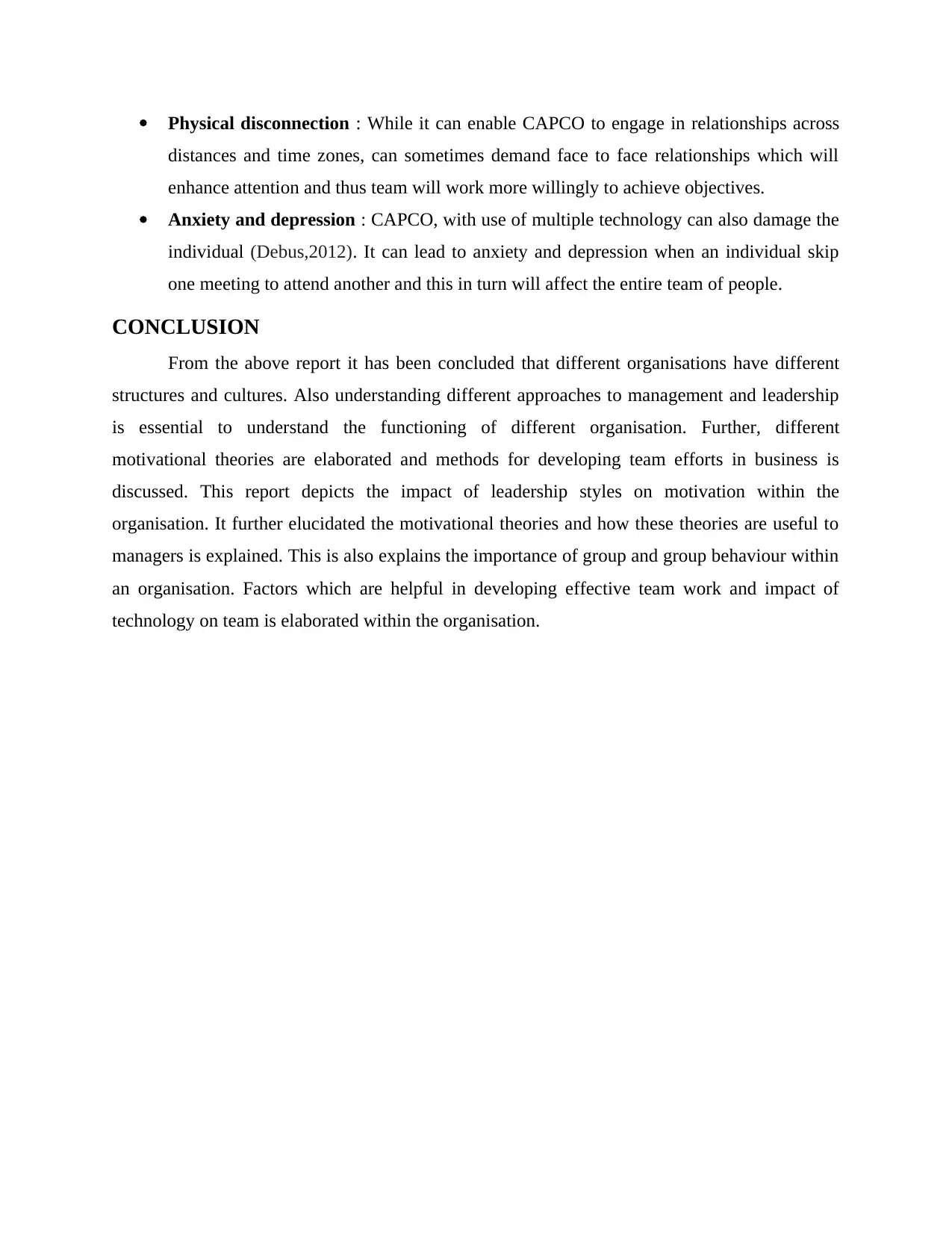
Physical disconnection : While it can enable CAPCO to engage in relationships across
distances and time zones, can sometimes demand face to face relationships which will
enhance attention and thus team will work more willingly to achieve objectives.
Anxiety and depression : CAPCO, with use of multiple technology can also damage the
individual (Debus,2012). It can lead to anxiety and depression when an individual skip
one meeting to attend another and this in turn will affect the entire team of people.
CONCLUSION
From the above report it has been concluded that different organisations have different
structures and cultures. Also understanding different approaches to management and leadership
is essential to understand the functioning of different organisation. Further, different
motivational theories are elaborated and methods for developing team efforts in business is
discussed. This report depicts the impact of leadership styles on motivation within the
organisation. It further elucidated the motivational theories and how these theories are useful to
managers is explained. This is also explains the importance of group and group behaviour within
an organisation. Factors which are helpful in developing effective team work and impact of
technology on team is elaborated within the organisation.
distances and time zones, can sometimes demand face to face relationships which will
enhance attention and thus team will work more willingly to achieve objectives.
Anxiety and depression : CAPCO, with use of multiple technology can also damage the
individual (Debus,2012). It can lead to anxiety and depression when an individual skip
one meeting to attend another and this in turn will affect the entire team of people.
CONCLUSION
From the above report it has been concluded that different organisations have different
structures and cultures. Also understanding different approaches to management and leadership
is essential to understand the functioning of different organisation. Further, different
motivational theories are elaborated and methods for developing team efforts in business is
discussed. This report depicts the impact of leadership styles on motivation within the
organisation. It further elucidated the motivational theories and how these theories are useful to
managers is explained. This is also explains the importance of group and group behaviour within
an organisation. Factors which are helpful in developing effective team work and impact of
technology on team is elaborated within the organisation.
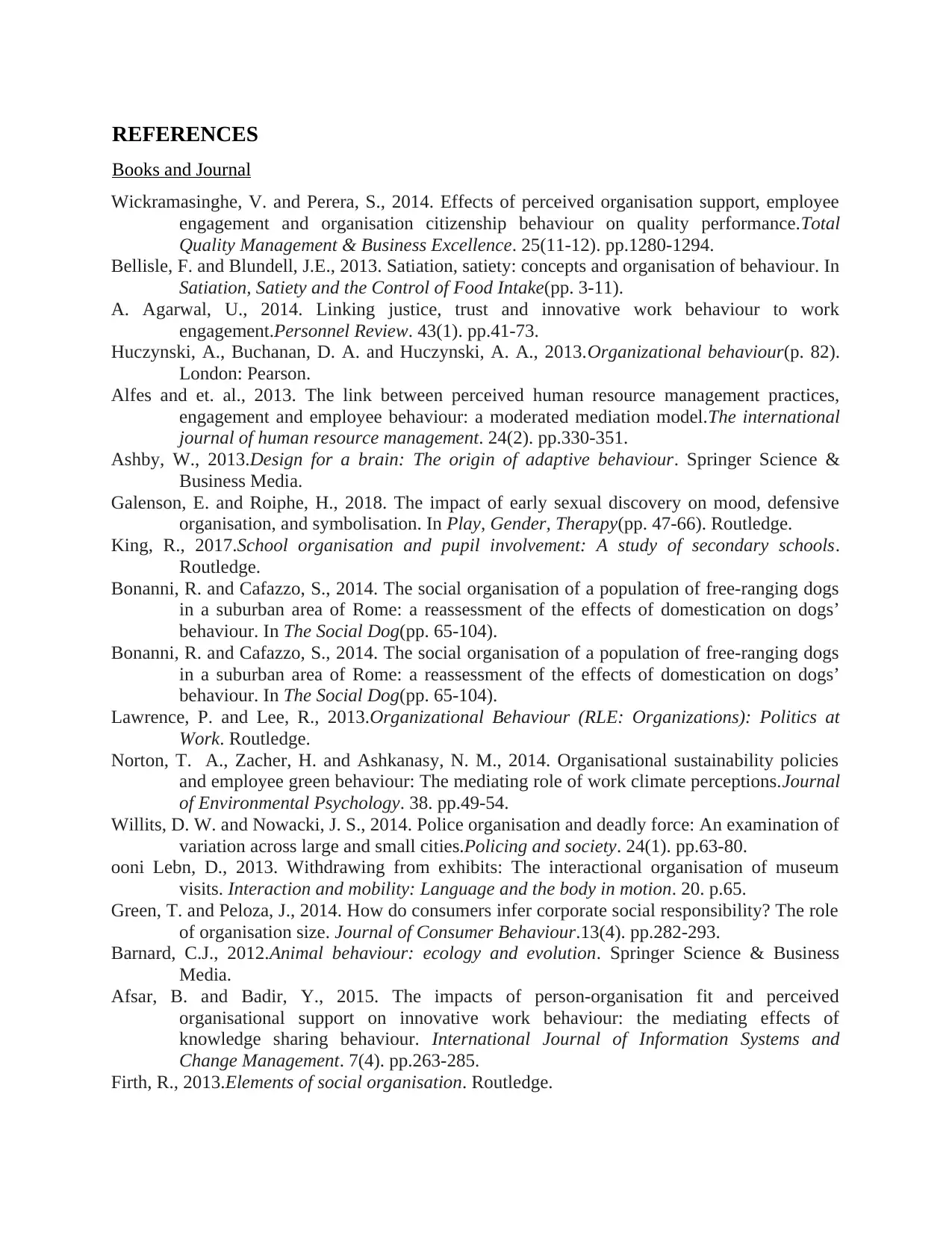
REFERENCES
Books and Journal
Wickramasinghe, V. and Perera, S., 2014. Effects of perceived organisation support, employee
engagement and organisation citizenship behaviour on quality performance.Total
Quality Management & Business Excellence. 25(11-12). pp.1280-1294.
Bellisle, F. and Blundell, J.E., 2013. Satiation, satiety: concepts and organisation of behaviour. In
Satiation, Satiety and the Control of Food Intake(pp. 3-11).
A. Agarwal, U., 2014. Linking justice, trust and innovative work behaviour to work
engagement.Personnel Review. 43(1). pp.41-73.
Huczynski, A., Buchanan, D. A. and Huczynski, A. A., 2013.Organizational behaviour(p. 82).
London: Pearson.
Alfes and et. al., 2013. The link between perceived human resource management practices,
engagement and employee behaviour: a moderated mediation model.The international
journal of human resource management. 24(2). pp.330-351.
Ashby, W., 2013.Design for a brain: The origin of adaptive behaviour. Springer Science &
Business Media.
Galenson, E. and Roiphe, H., 2018. The impact of early sexual discovery on mood, defensive
organisation, and symbolisation. In Play, Gender, Therapy(pp. 47-66). Routledge.
King, R., 2017.School organisation and pupil involvement: A study of secondary schools.
Routledge.
Bonanni, R. and Cafazzo, S., 2014. The social organisation of a population of free-ranging dogs
in a suburban area of Rome: a reassessment of the effects of domestication on dogs’
behaviour. In The Social Dog(pp. 65-104).
Bonanni, R. and Cafazzo, S., 2014. The social organisation of a population of free-ranging dogs
in a suburban area of Rome: a reassessment of the effects of domestication on dogs’
behaviour. In The Social Dog(pp. 65-104).
Lawrence, P. and Lee, R., 2013.Organizational Behaviour (RLE: Organizations): Politics at
Work. Routledge.
Norton, T. A., Zacher, H. and Ashkanasy, N. M., 2014. Organisational sustainability policies
and employee green behaviour: The mediating role of work climate perceptions.Journal
of Environmental Psychology. 38. pp.49-54.
Willits, D. W. and Nowacki, J. S., 2014. Police organisation and deadly force: An examination of
variation across large and small cities.Policing and society. 24(1). pp.63-80.
ooni Lebn, D., 2013. Withdrawing from exhibits: The interactional organisation of museum
visits. Interaction and mobility: Language and the body in motion. 20. p.65.
Green, T. and Peloza, J., 2014. How do consumers infer corporate social responsibility? The role
of organisation size. Journal of Consumer Behaviour.13(4). pp.282-293.
Barnard, C.J., 2012.Animal behaviour: ecology and evolution. Springer Science & Business
Media.
Afsar, B. and Badir, Y., 2015. The impacts of person-organisation fit and perceived
organisational support on innovative work behaviour: the mediating effects of
knowledge sharing behaviour. International Journal of Information Systems and
Change Management. 7(4). pp.263-285.
Firth, R., 2013.Elements of social organisation. Routledge.
Books and Journal
Wickramasinghe, V. and Perera, S., 2014. Effects of perceived organisation support, employee
engagement and organisation citizenship behaviour on quality performance.Total
Quality Management & Business Excellence. 25(11-12). pp.1280-1294.
Bellisle, F. and Blundell, J.E., 2013. Satiation, satiety: concepts and organisation of behaviour. In
Satiation, Satiety and the Control of Food Intake(pp. 3-11).
A. Agarwal, U., 2014. Linking justice, trust and innovative work behaviour to work
engagement.Personnel Review. 43(1). pp.41-73.
Huczynski, A., Buchanan, D. A. and Huczynski, A. A., 2013.Organizational behaviour(p. 82).
London: Pearson.
Alfes and et. al., 2013. The link between perceived human resource management practices,
engagement and employee behaviour: a moderated mediation model.The international
journal of human resource management. 24(2). pp.330-351.
Ashby, W., 2013.Design for a brain: The origin of adaptive behaviour. Springer Science &
Business Media.
Galenson, E. and Roiphe, H., 2018. The impact of early sexual discovery on mood, defensive
organisation, and symbolisation. In Play, Gender, Therapy(pp. 47-66). Routledge.
King, R., 2017.School organisation and pupil involvement: A study of secondary schools.
Routledge.
Bonanni, R. and Cafazzo, S., 2014. The social organisation of a population of free-ranging dogs
in a suburban area of Rome: a reassessment of the effects of domestication on dogs’
behaviour. In The Social Dog(pp. 65-104).
Bonanni, R. and Cafazzo, S., 2014. The social organisation of a population of free-ranging dogs
in a suburban area of Rome: a reassessment of the effects of domestication on dogs’
behaviour. In The Social Dog(pp. 65-104).
Lawrence, P. and Lee, R., 2013.Organizational Behaviour (RLE: Organizations): Politics at
Work. Routledge.
Norton, T. A., Zacher, H. and Ashkanasy, N. M., 2014. Organisational sustainability policies
and employee green behaviour: The mediating role of work climate perceptions.Journal
of Environmental Psychology. 38. pp.49-54.
Willits, D. W. and Nowacki, J. S., 2014. Police organisation and deadly force: An examination of
variation across large and small cities.Policing and society. 24(1). pp.63-80.
ooni Lebn, D., 2013. Withdrawing from exhibits: The interactional organisation of museum
visits. Interaction and mobility: Language and the body in motion. 20. p.65.
Green, T. and Peloza, J., 2014. How do consumers infer corporate social responsibility? The role
of organisation size. Journal of Consumer Behaviour.13(4). pp.282-293.
Barnard, C.J., 2012.Animal behaviour: ecology and evolution. Springer Science & Business
Media.
Afsar, B. and Badir, Y., 2015. The impacts of person-organisation fit and perceived
organisational support on innovative work behaviour: the mediating effects of
knowledge sharing behaviour. International Journal of Information Systems and
Change Management. 7(4). pp.263-285.
Firth, R., 2013.Elements of social organisation. Routledge.
Paraphrase This Document
Need a fresh take? Get an instant paraphrase of this document with our AI Paraphraser
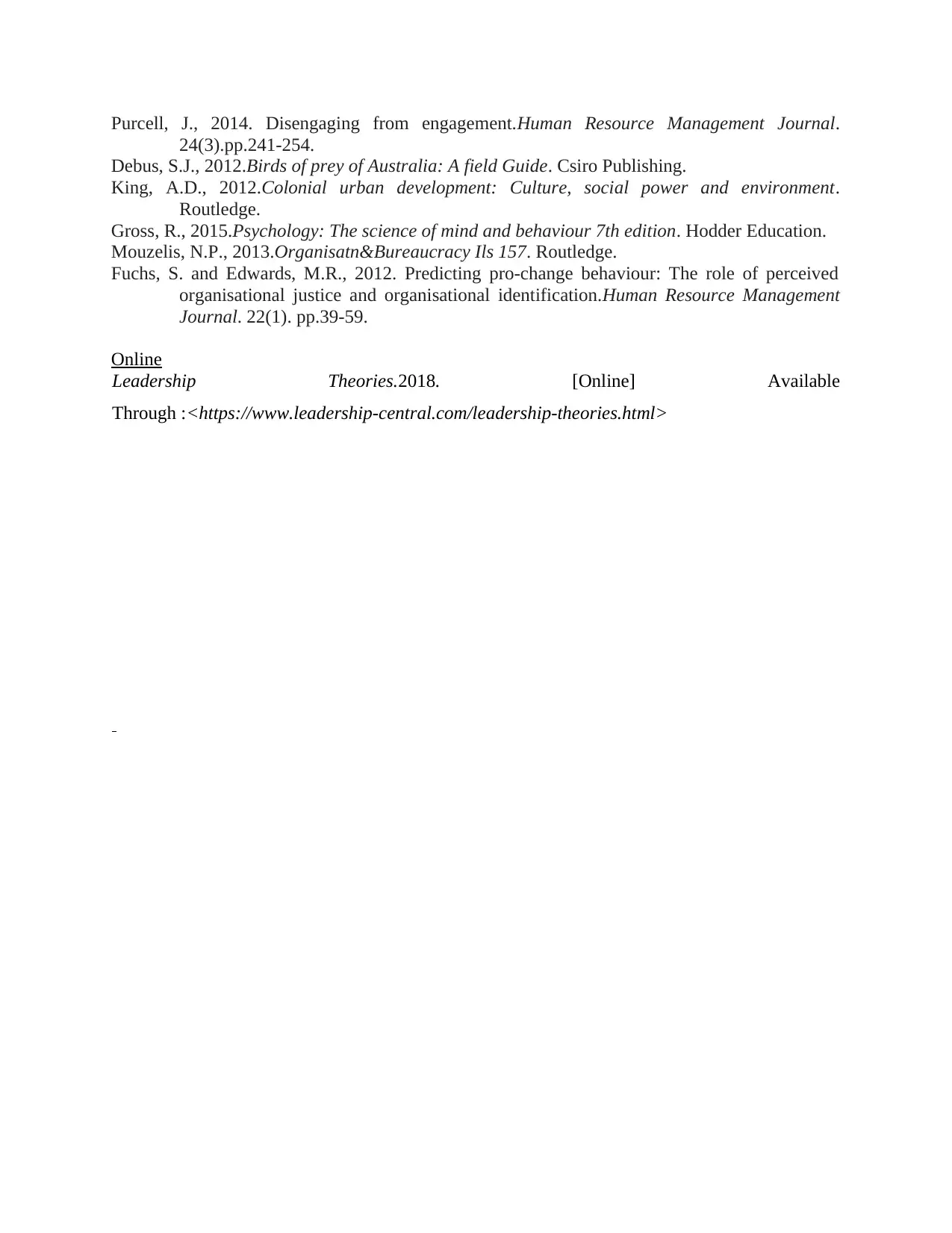
Purcell, J., 2014. Disengaging from engagement.Human Resource Management Journal.
24(3).pp.241-254.
Debus, S.J., 2012.Birds of prey of Australia: A field Guide. Csiro Publishing.
King, A.D., 2012.Colonial urban development: Culture, social power and environment.
Routledge.
Gross, R., 2015.Psychology: The science of mind and behaviour 7th edition. Hodder Education.
Mouzelis, N.P., 2013.Organisatn&Bureaucracy Ils 157. Routledge.
Fuchs, S. and Edwards, M.R., 2012. Predicting pro‐change behaviour: The role of perceived
organisational justice and organisational identification.Human Resource Management
Journal. 22(1). pp.39-59.
Online
Leadership Theories.2018. [Online] Available
Through :<https://www.leadership-central.com/leadership-theories.html>
24(3).pp.241-254.
Debus, S.J., 2012.Birds of prey of Australia: A field Guide. Csiro Publishing.
King, A.D., 2012.Colonial urban development: Culture, social power and environment.
Routledge.
Gross, R., 2015.Psychology: The science of mind and behaviour 7th edition. Hodder Education.
Mouzelis, N.P., 2013.Organisatn&Bureaucracy Ils 157. Routledge.
Fuchs, S. and Edwards, M.R., 2012. Predicting pro‐change behaviour: The role of perceived
organisational justice and organisational identification.Human Resource Management
Journal. 22(1). pp.39-59.
Online
Leadership Theories.2018. [Online] Available
Through :<https://www.leadership-central.com/leadership-theories.html>
1 out of 20
Related Documents
Your All-in-One AI-Powered Toolkit for Academic Success.
+13062052269
info@desklib.com
Available 24*7 on WhatsApp / Email
![[object Object]](/_next/static/media/star-bottom.7253800d.svg)
Unlock your academic potential
© 2024 | Zucol Services PVT LTD | All rights reserved.





